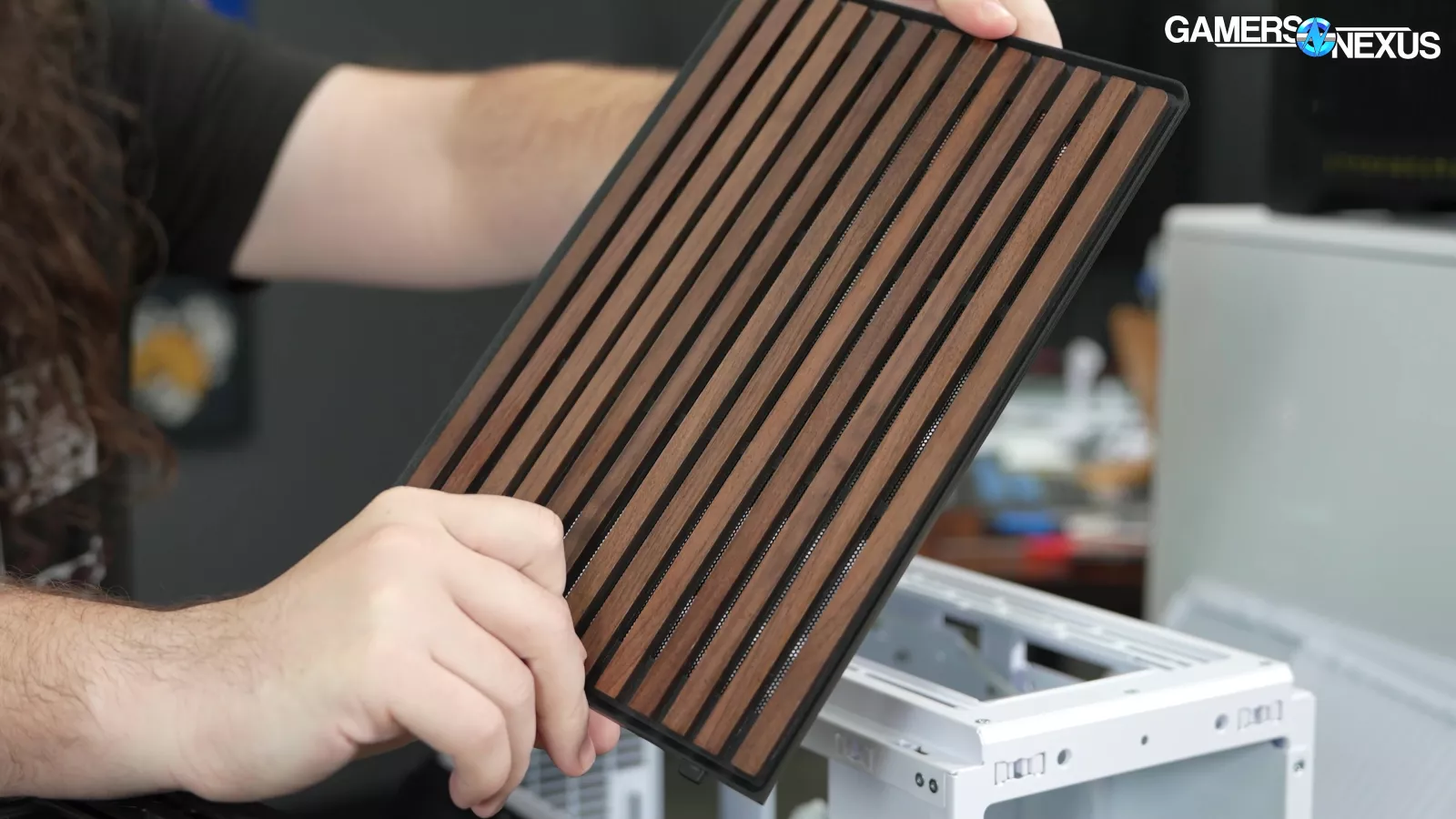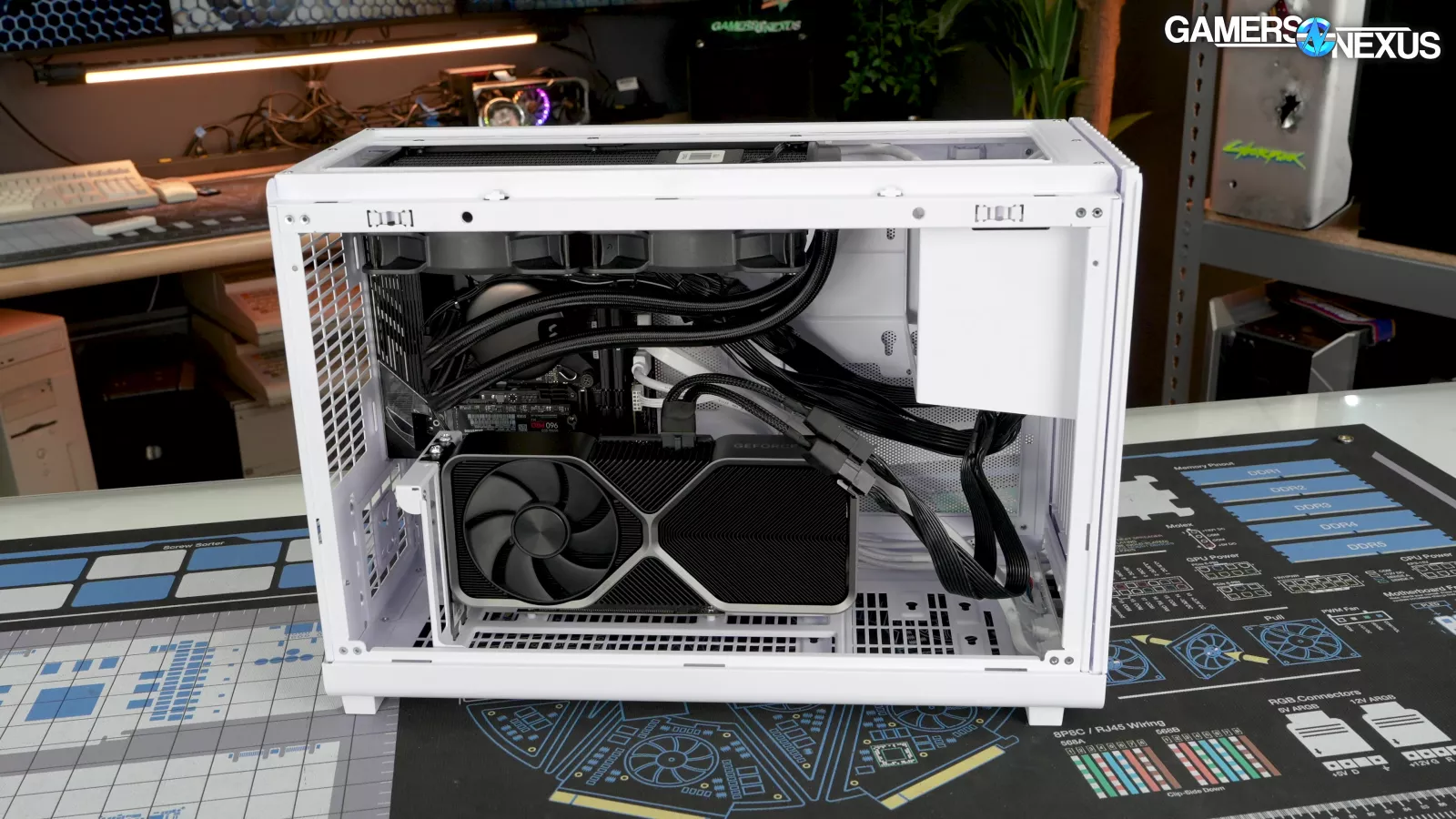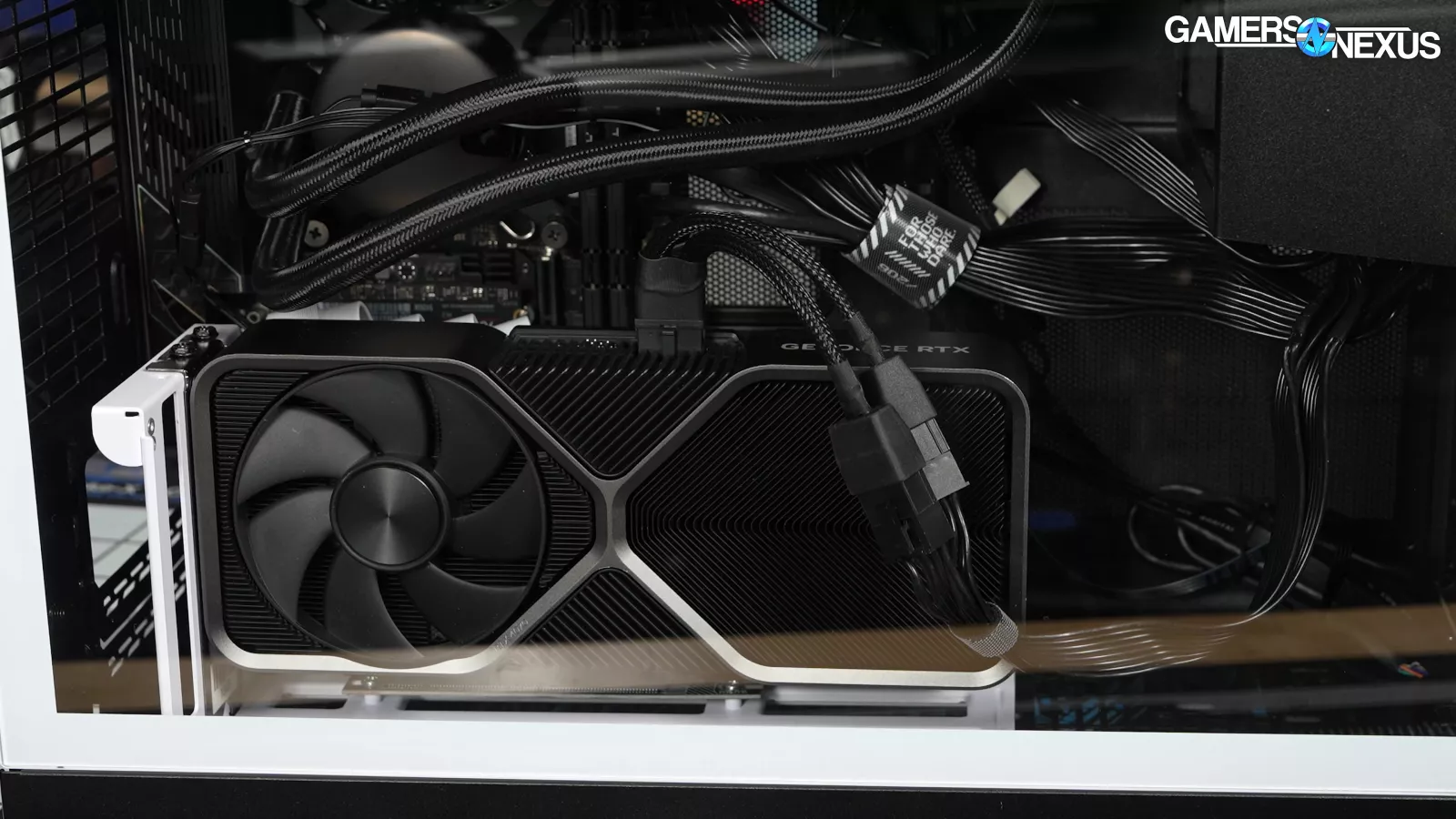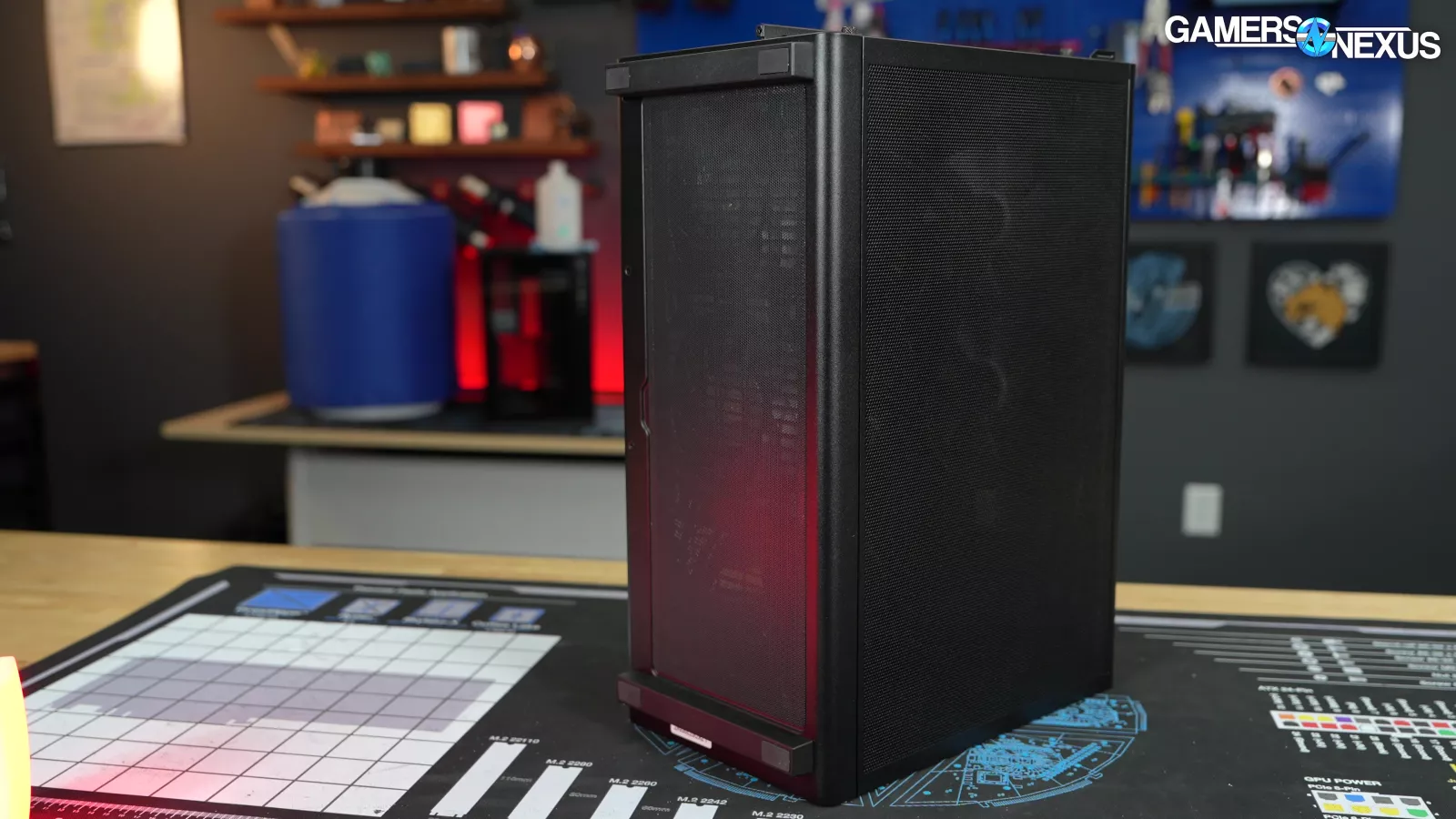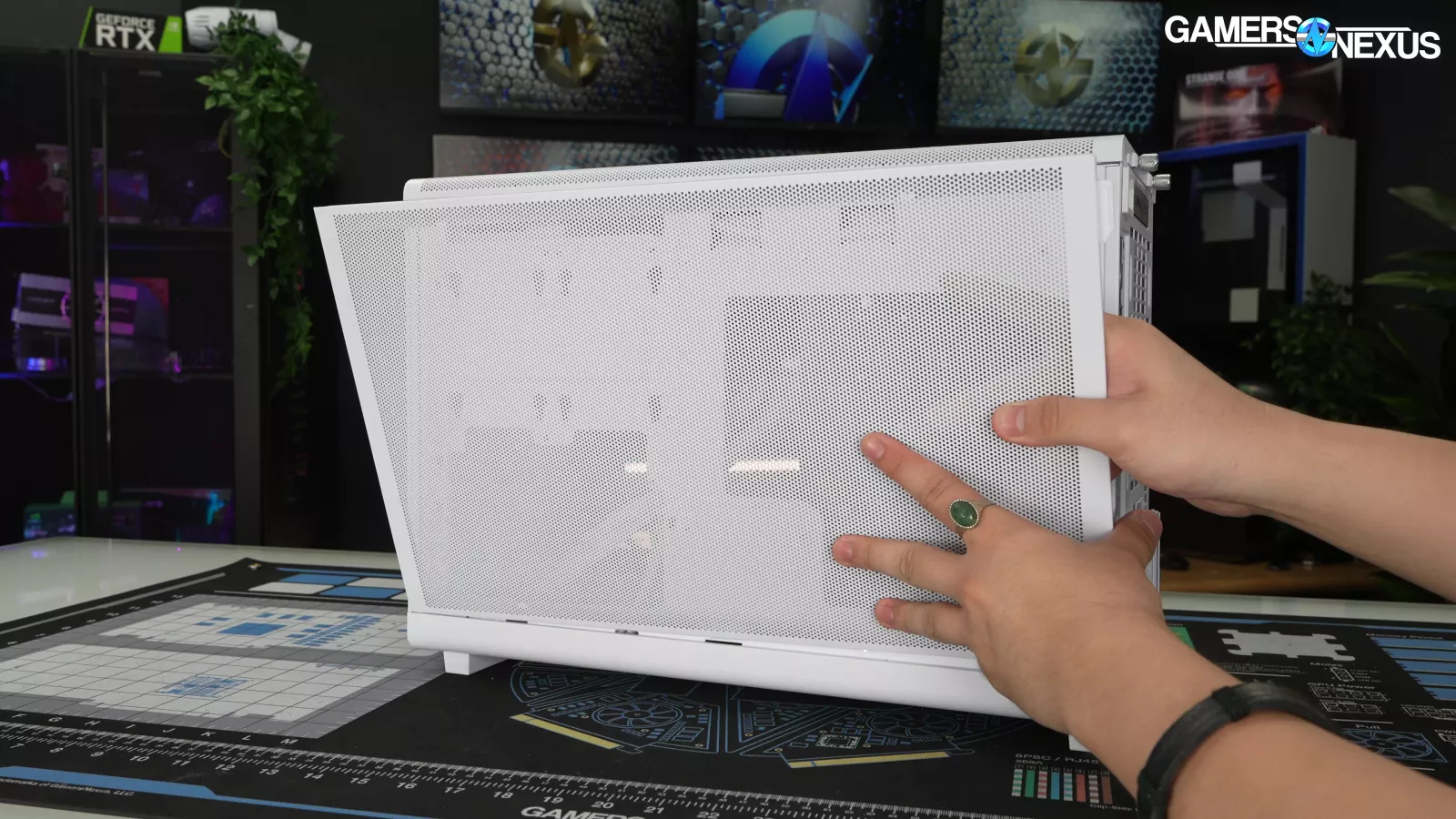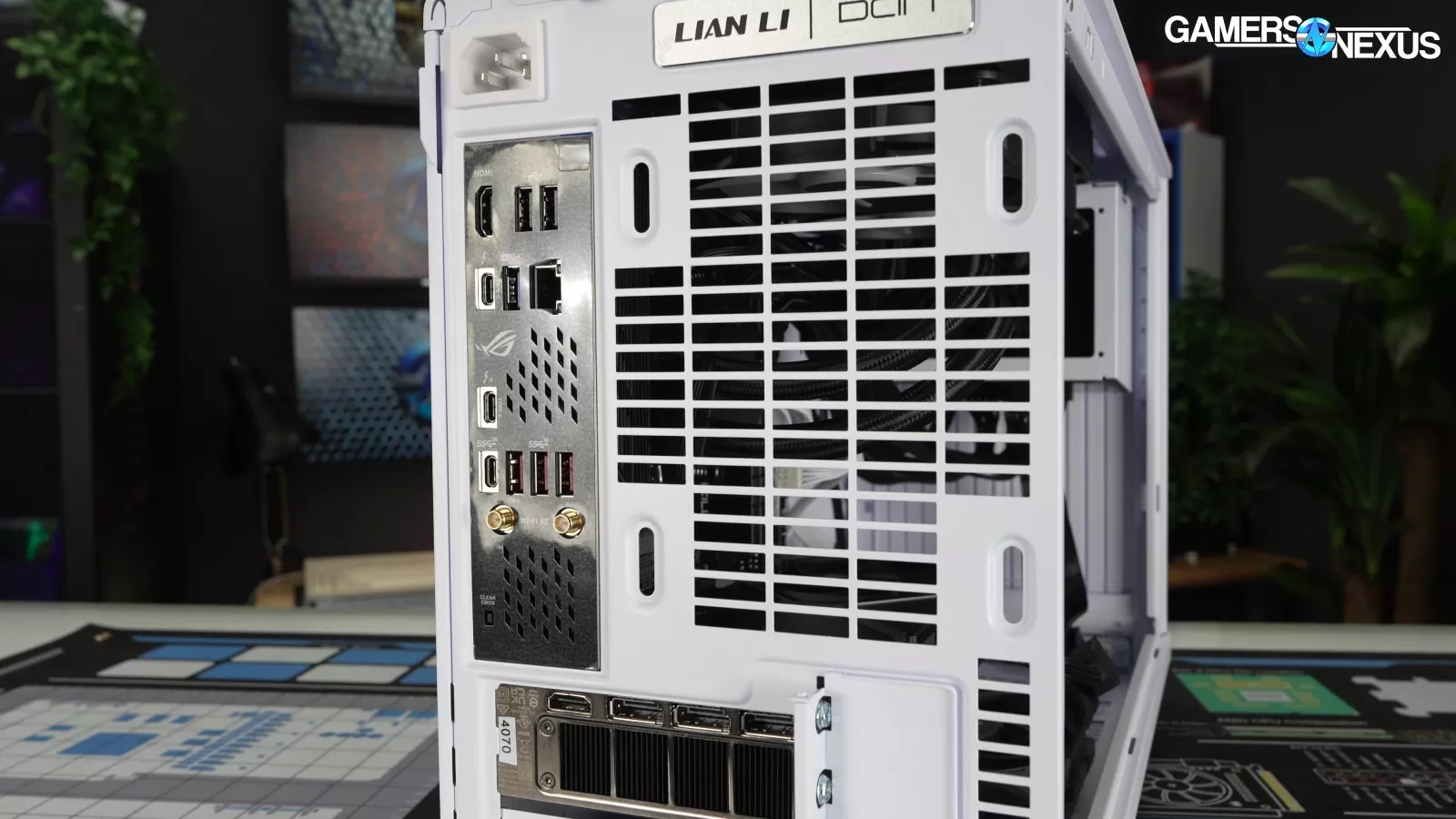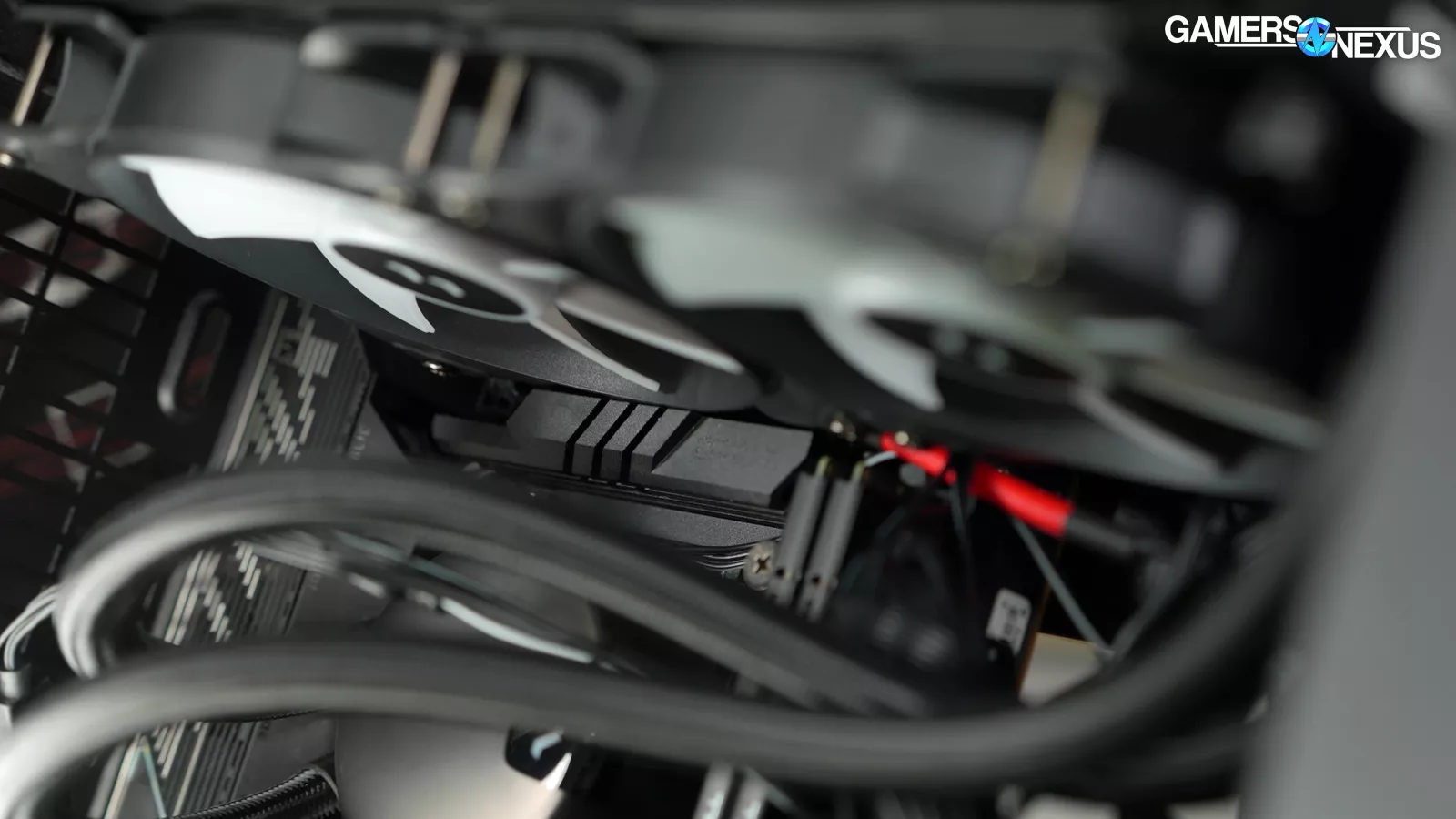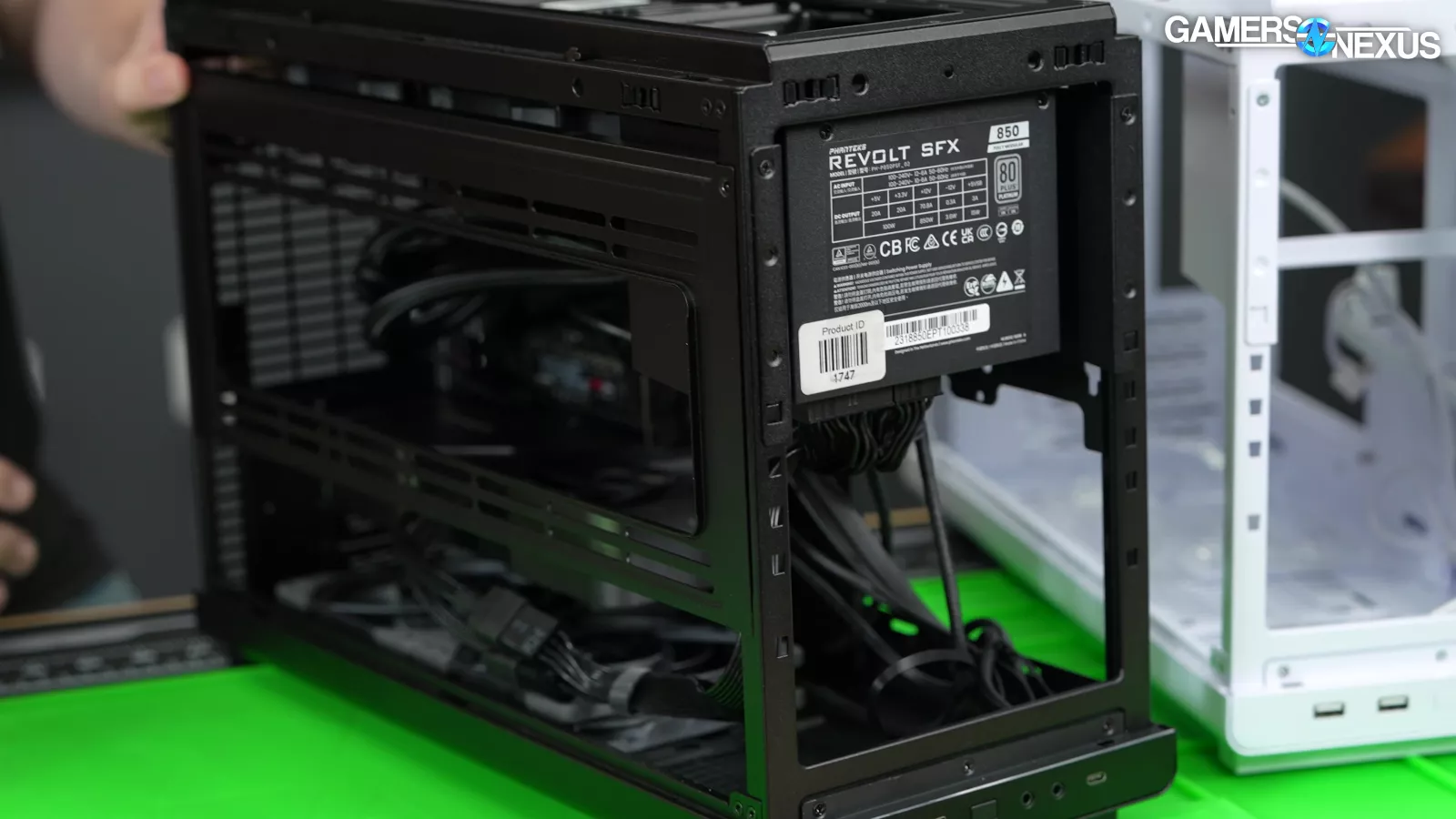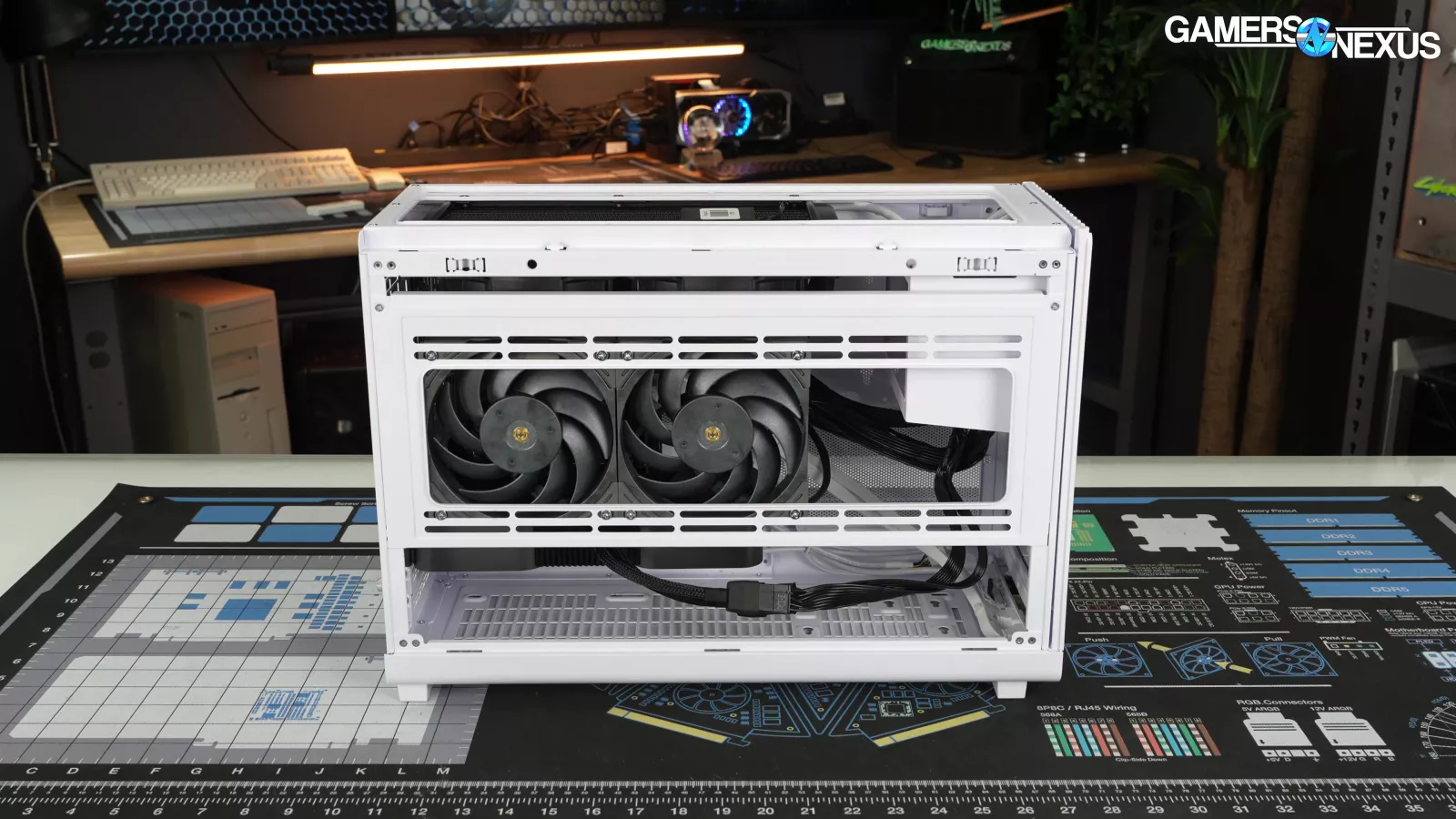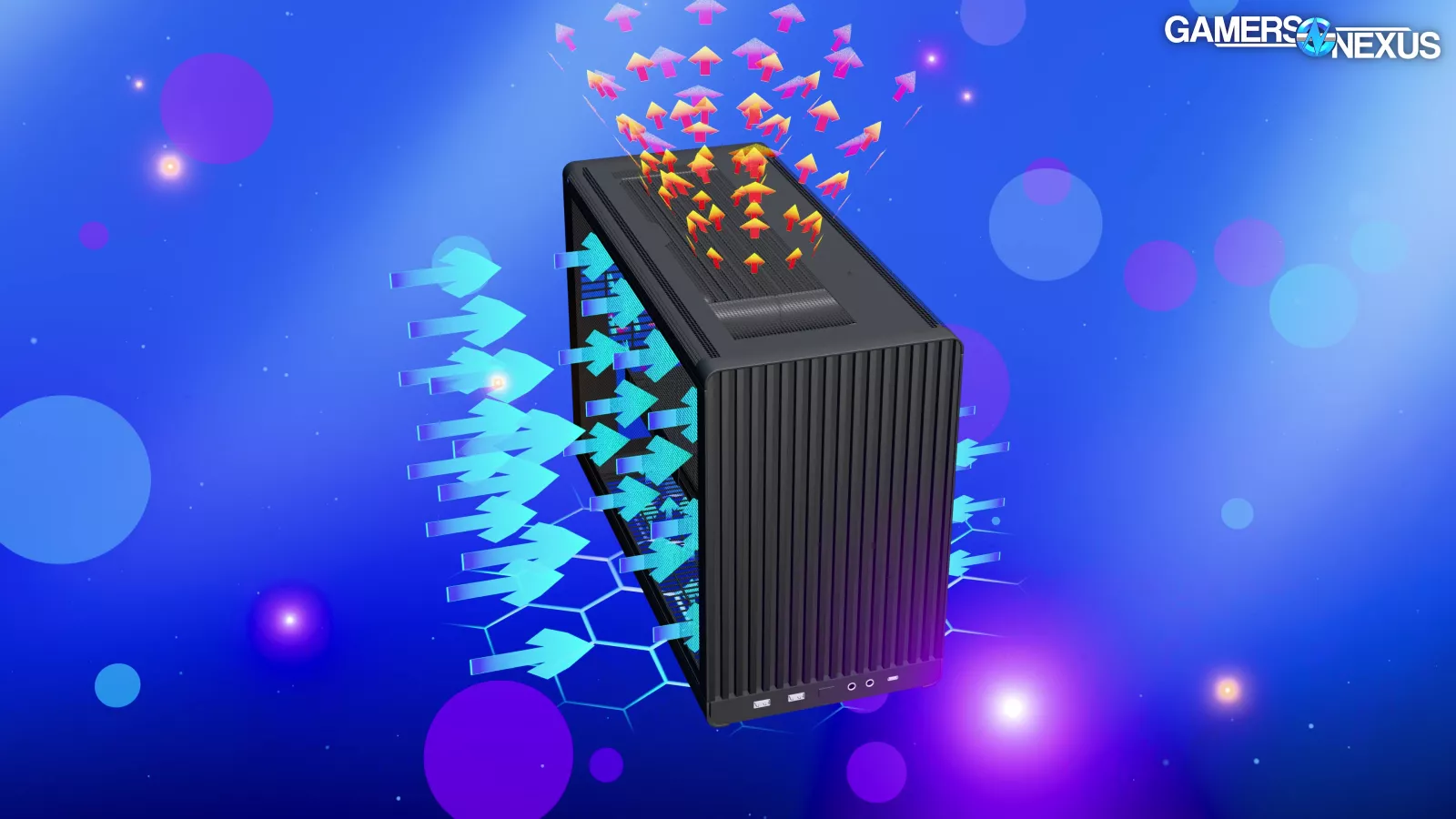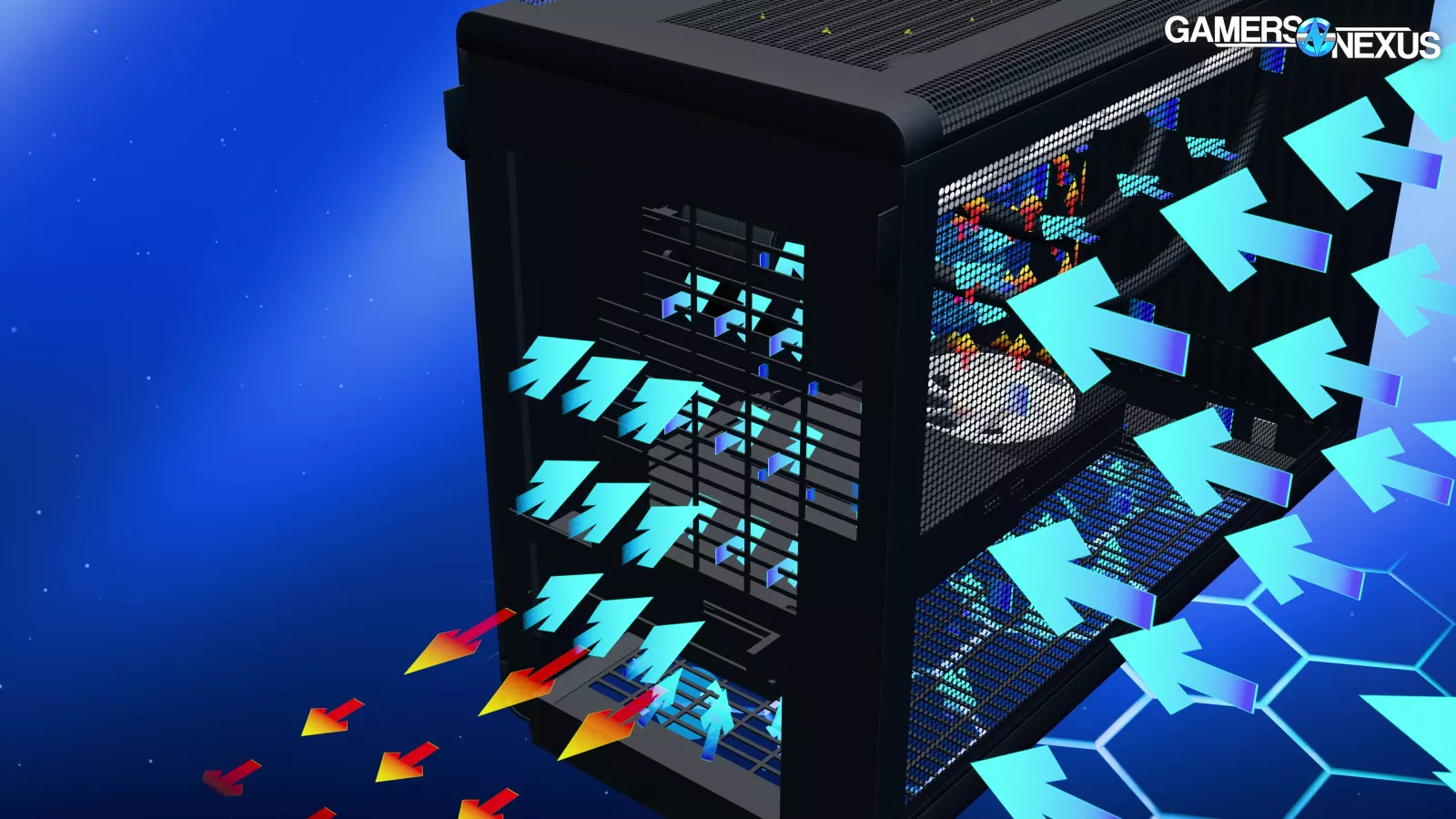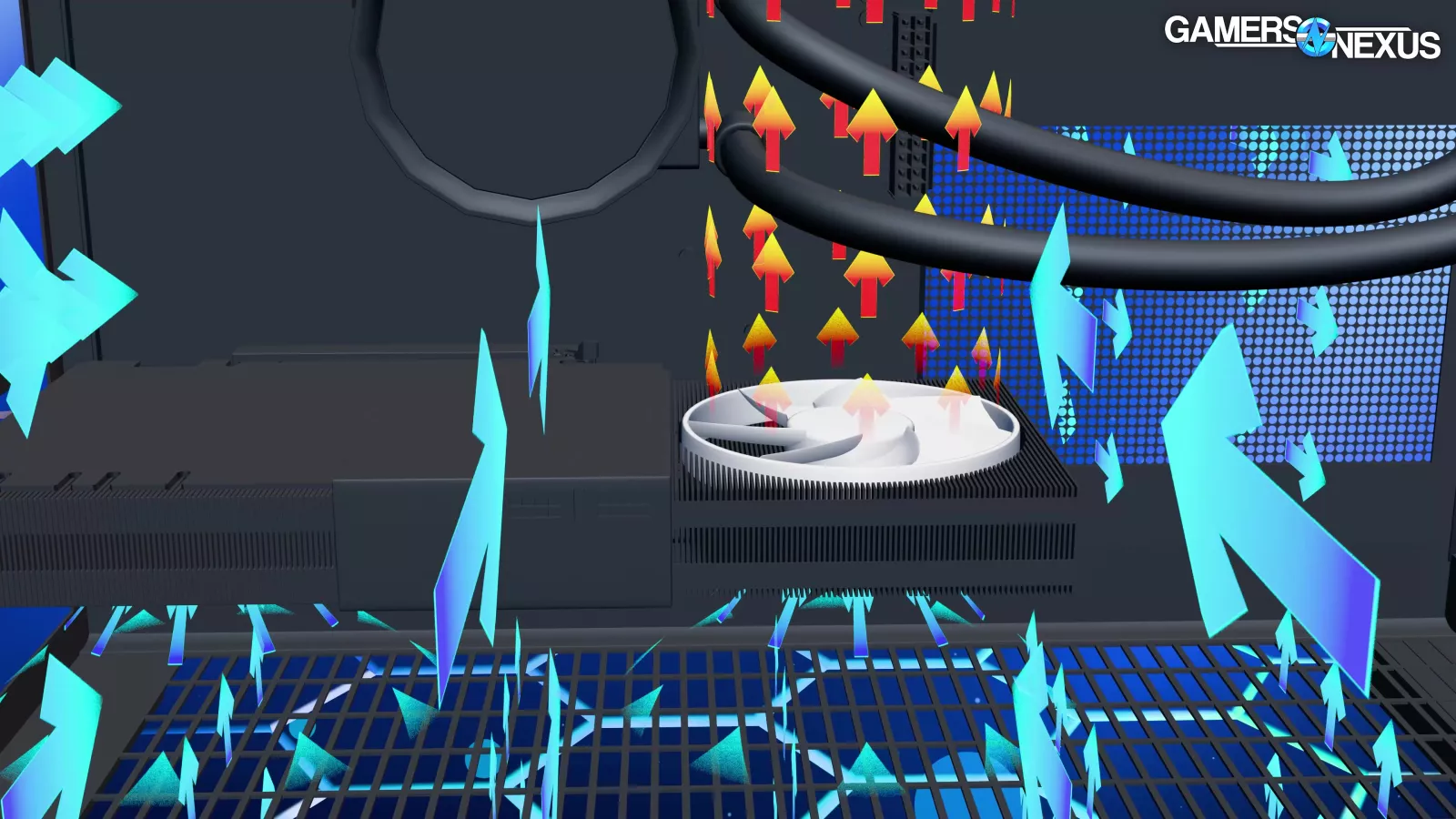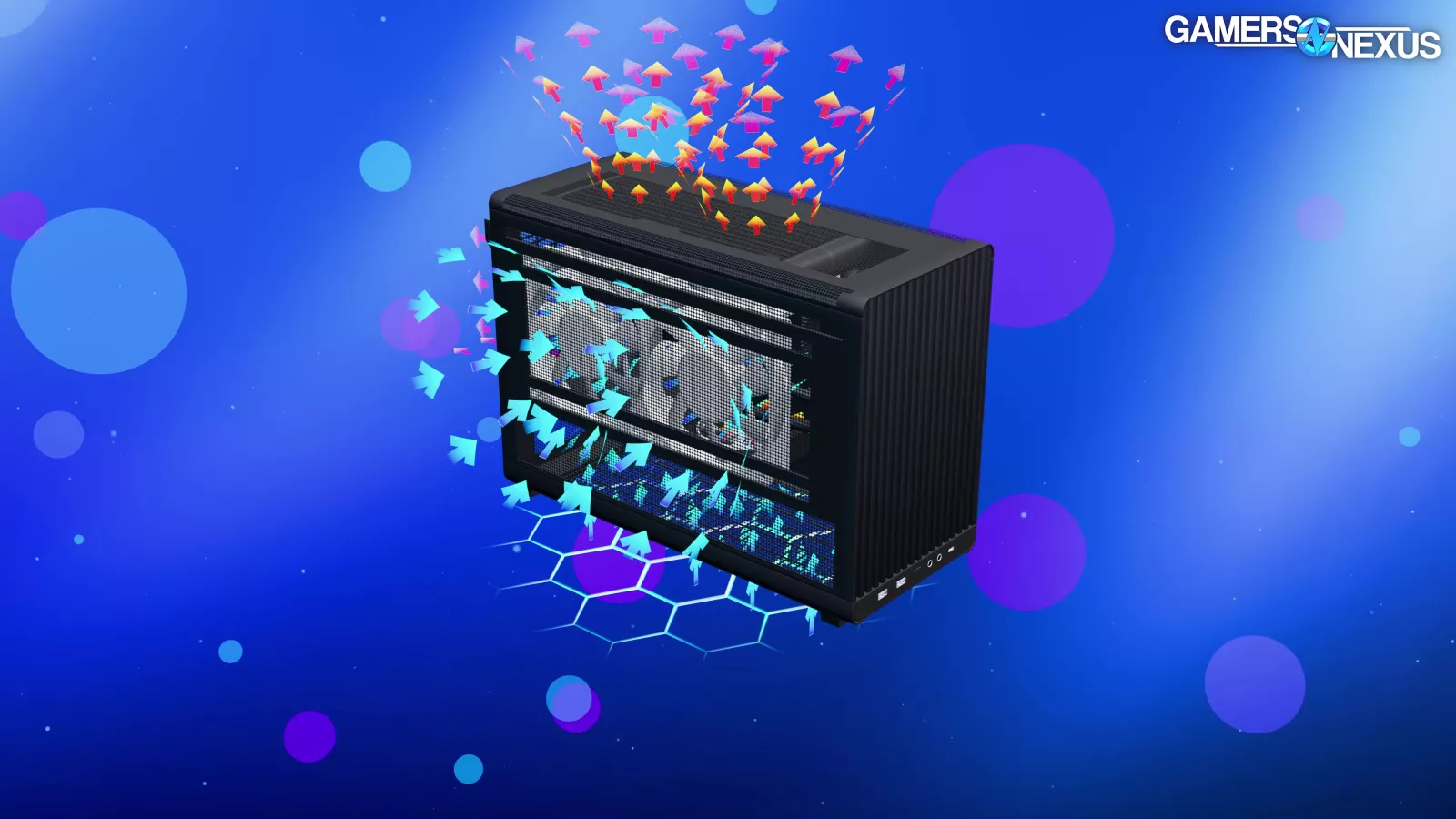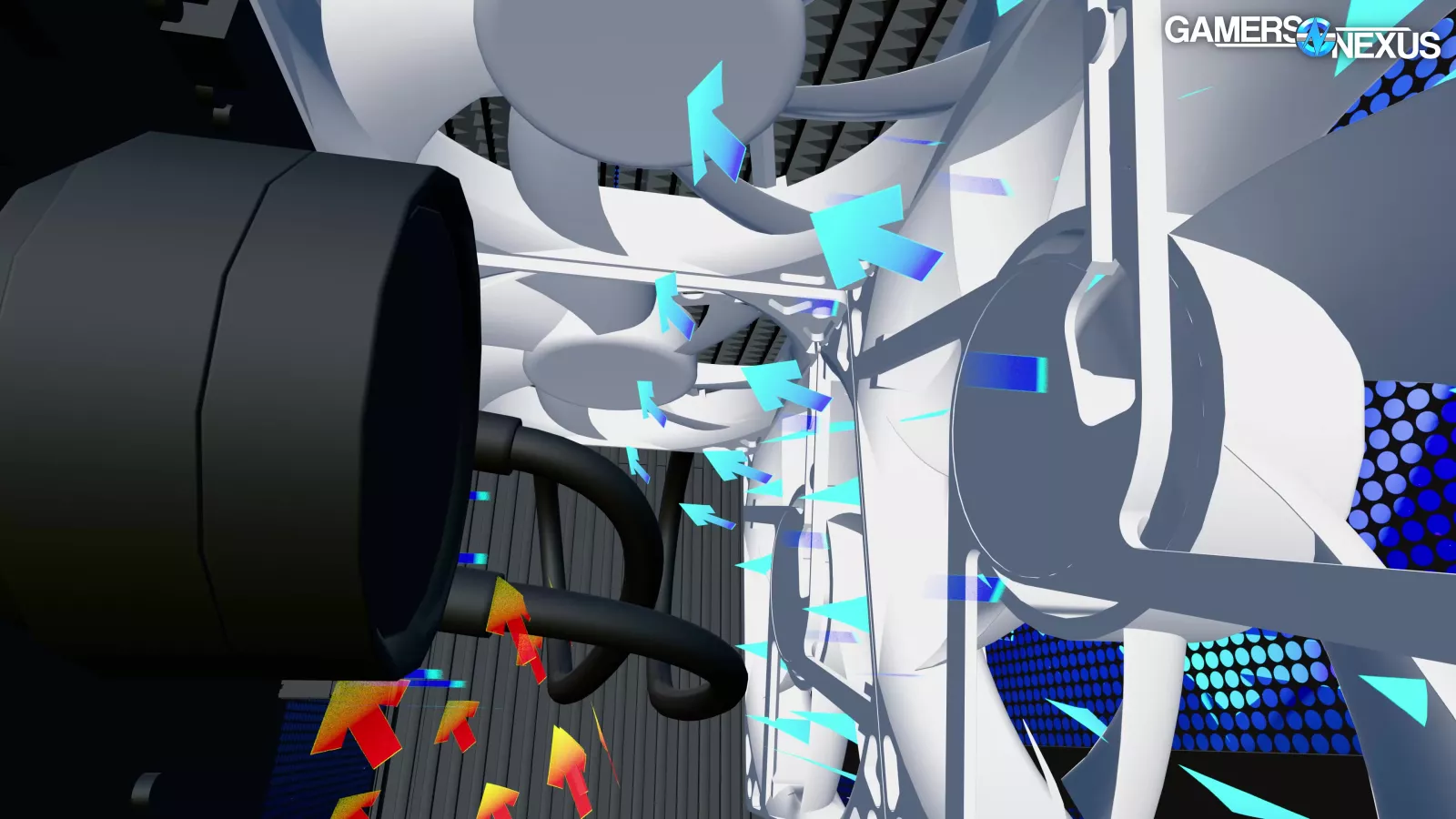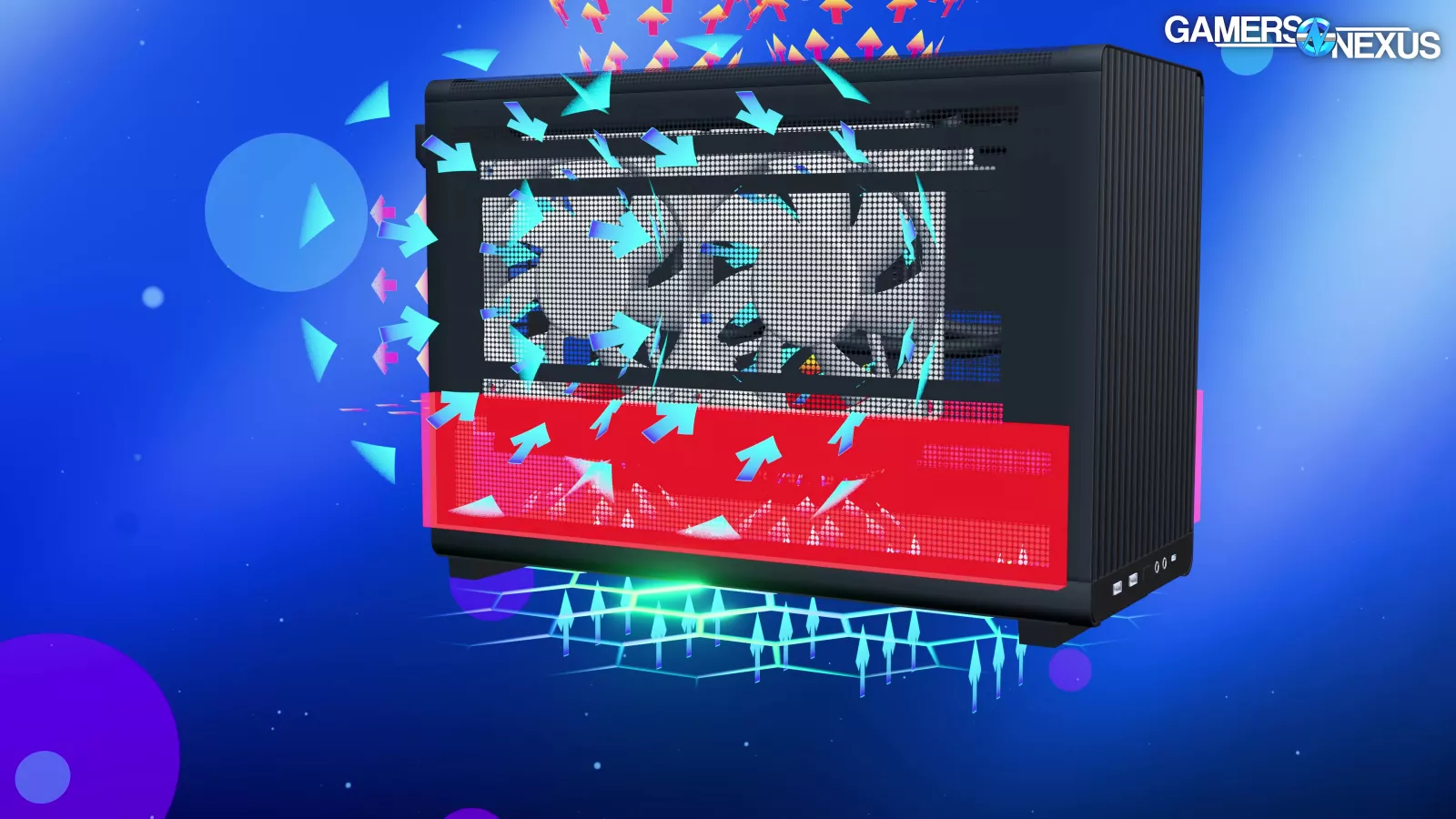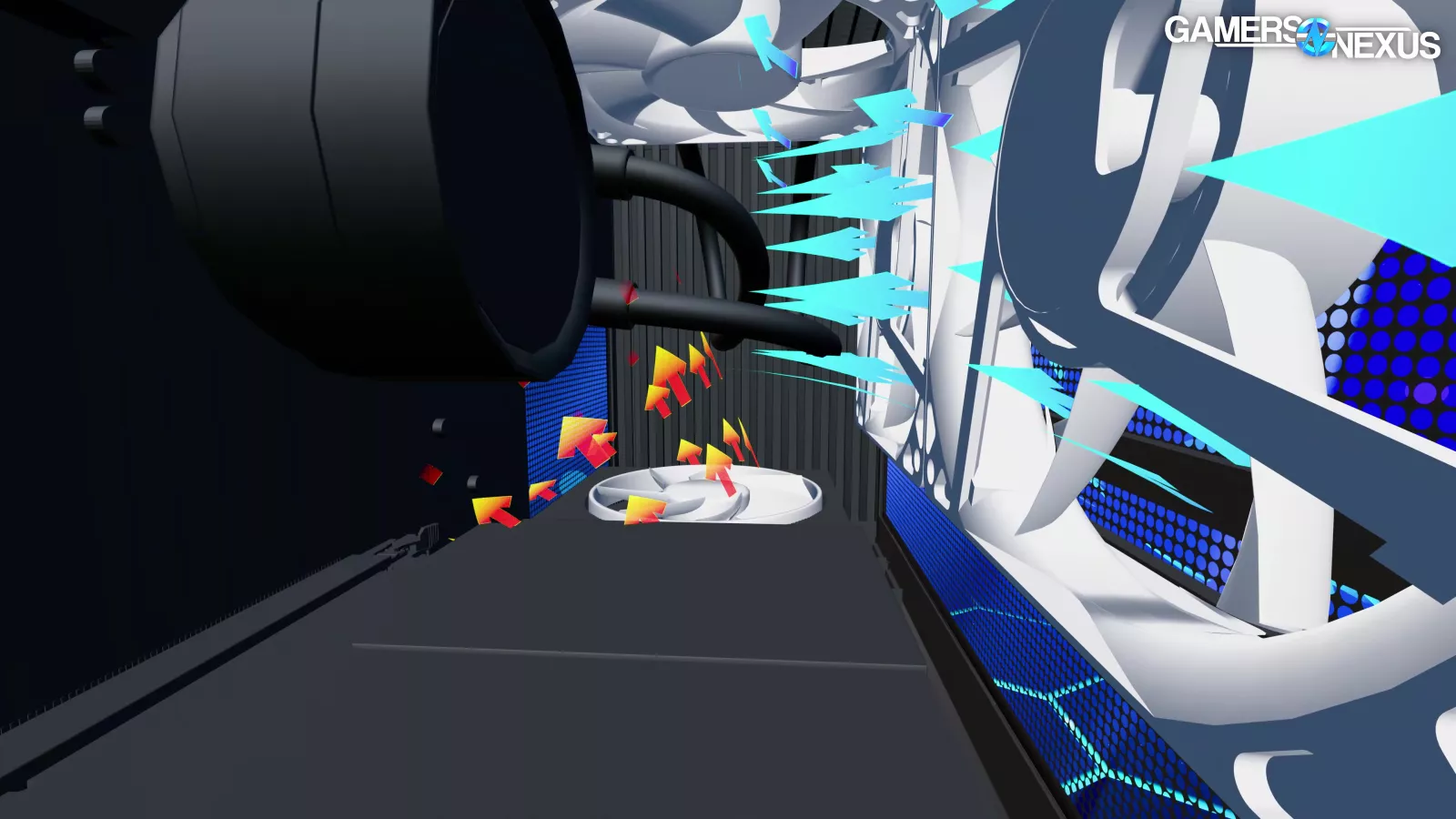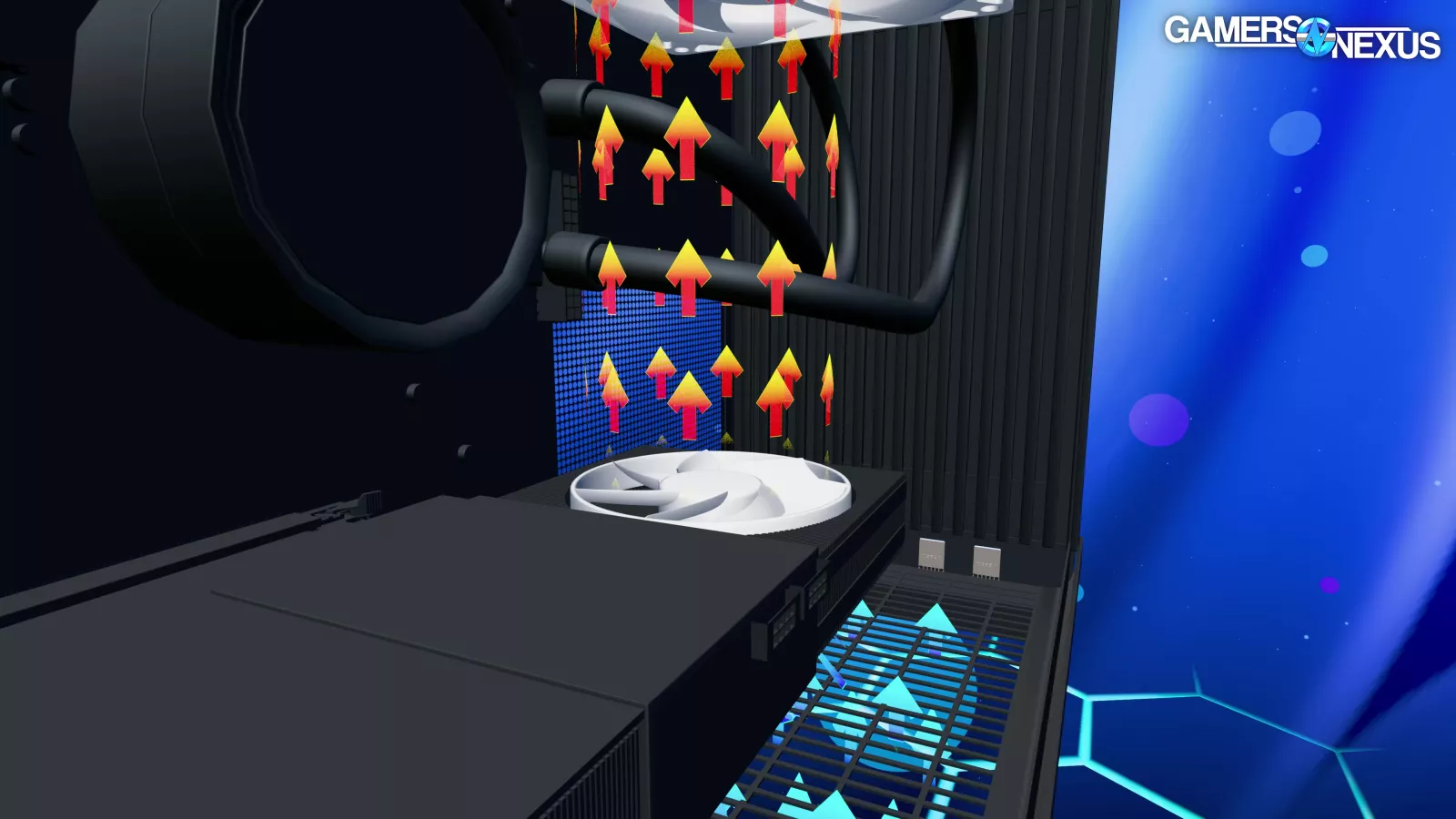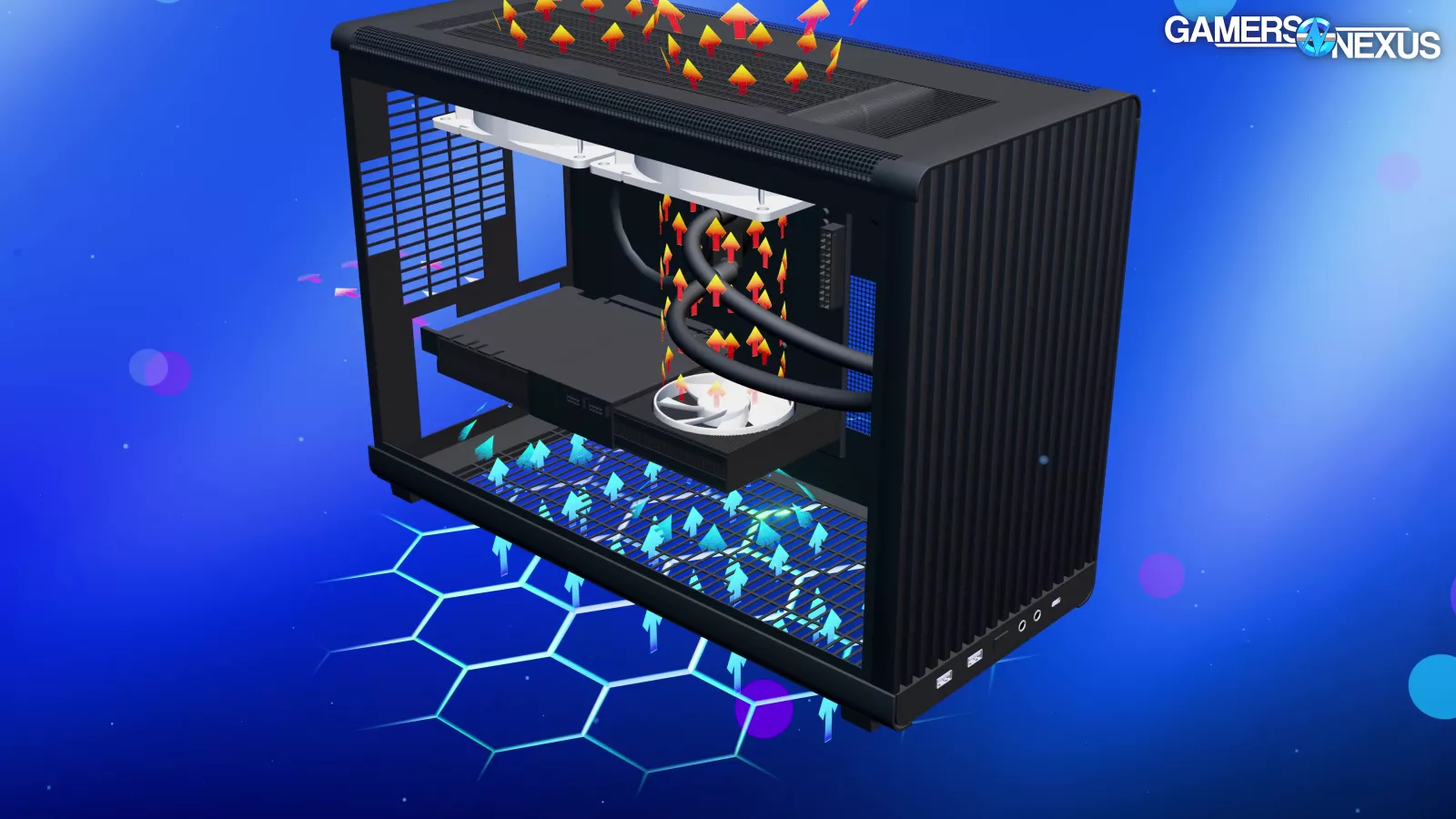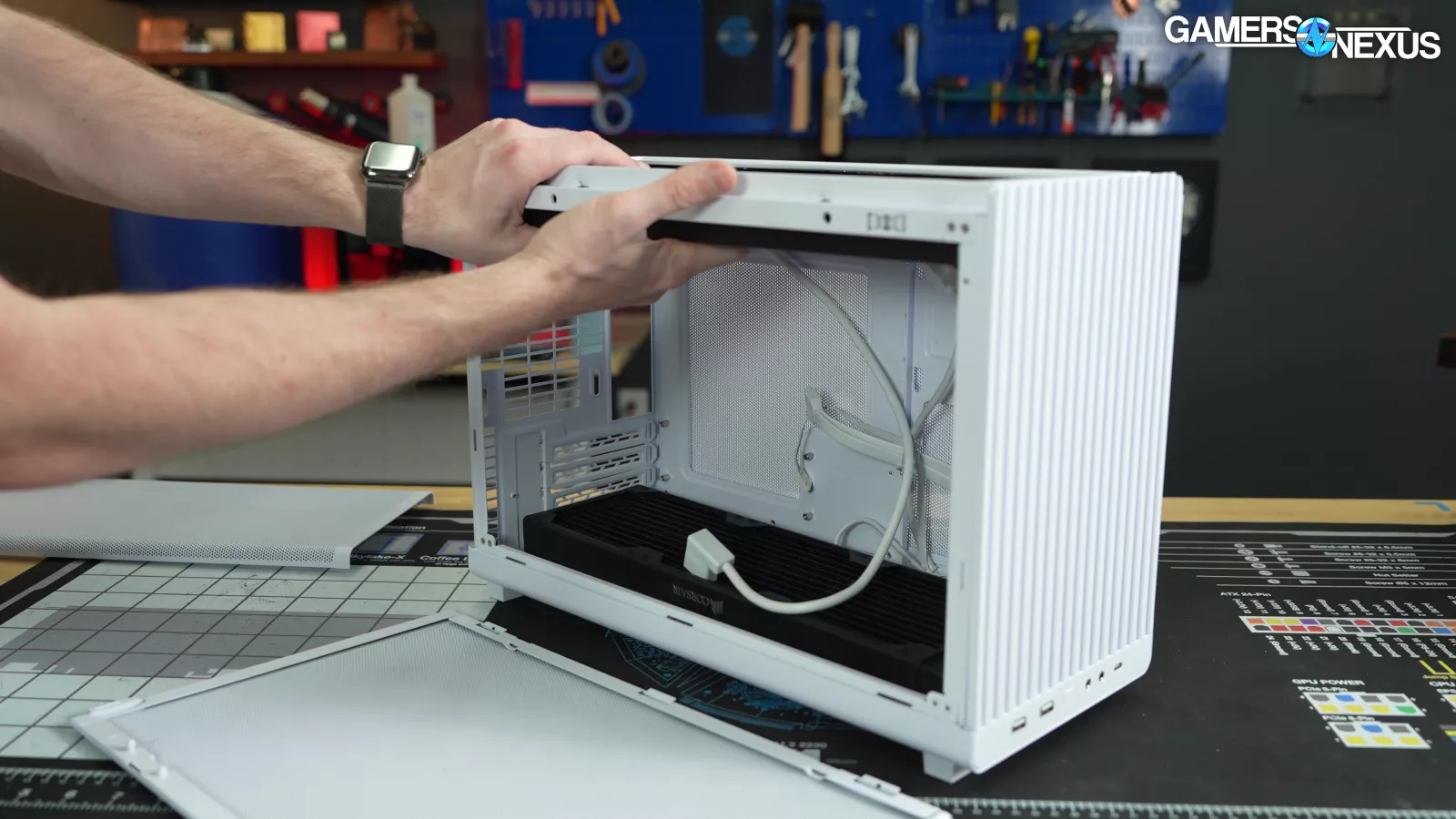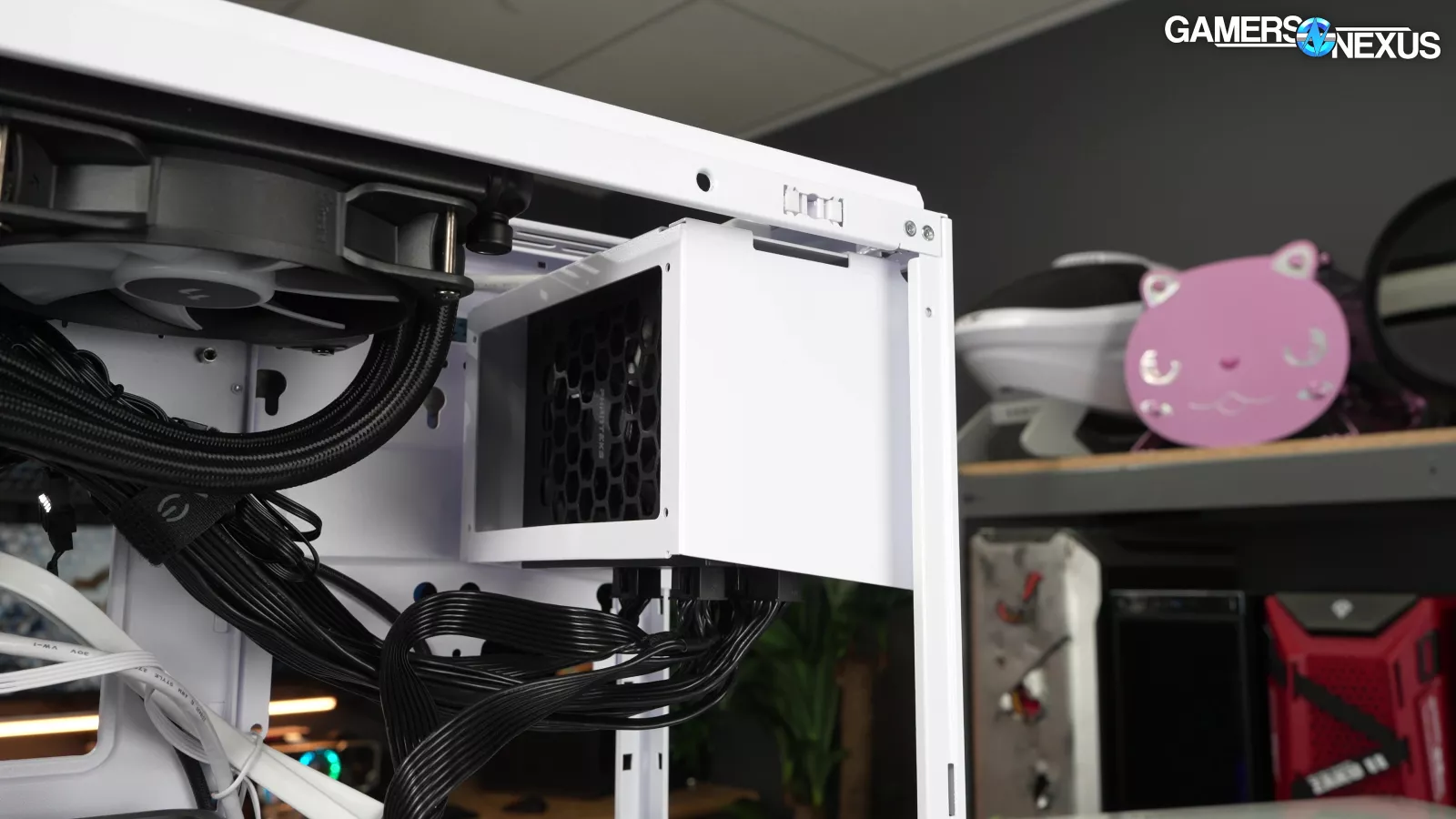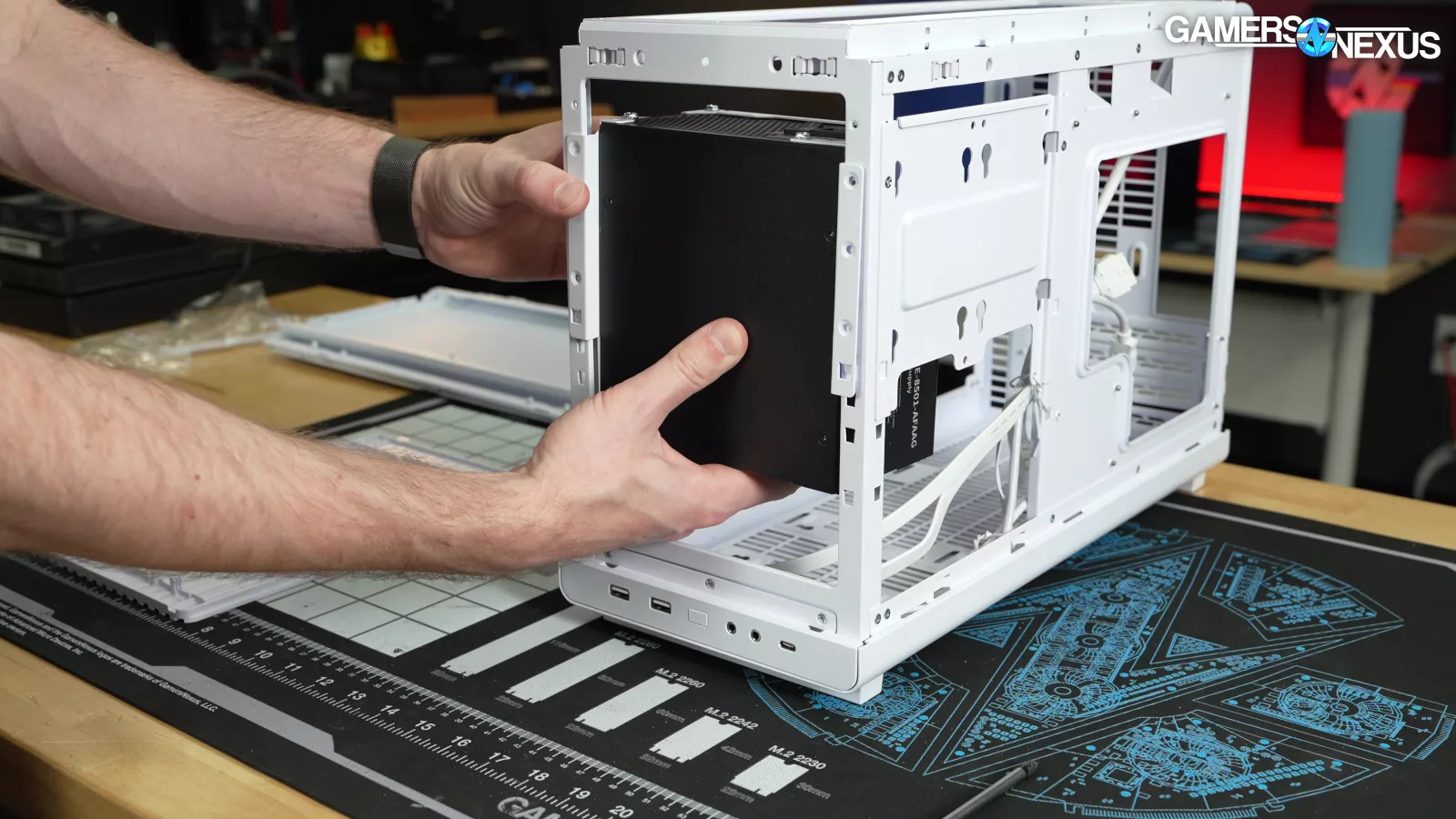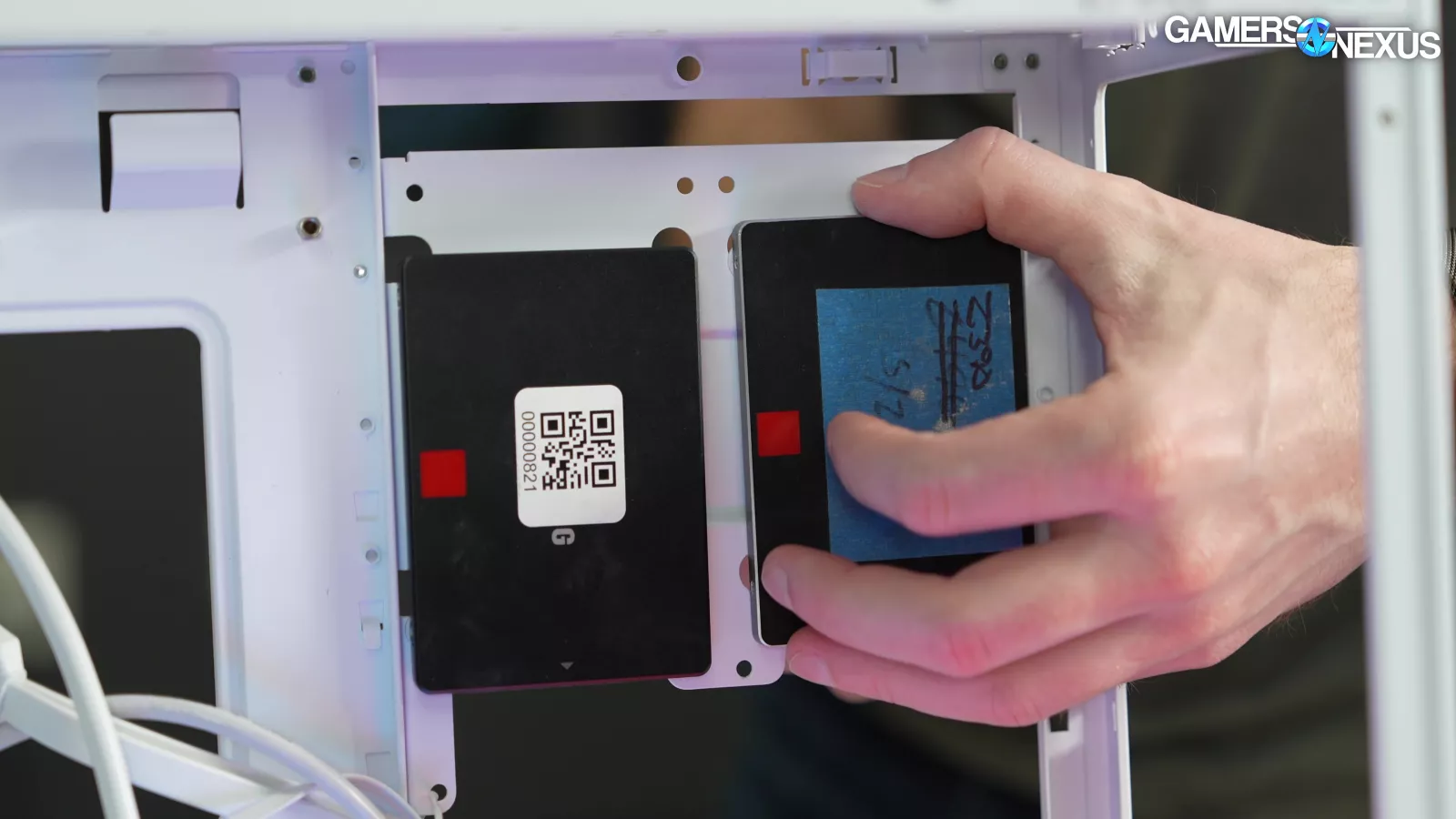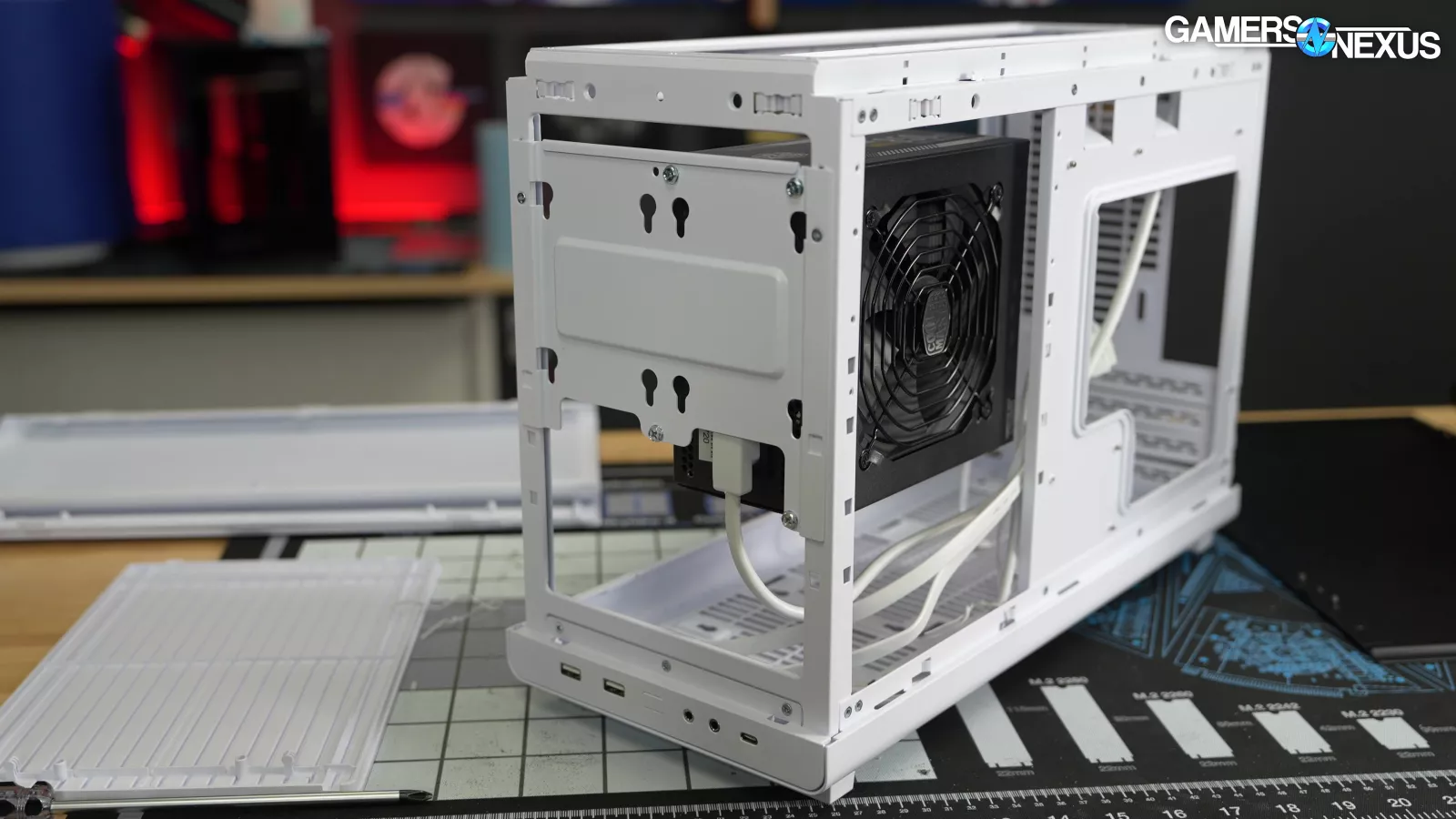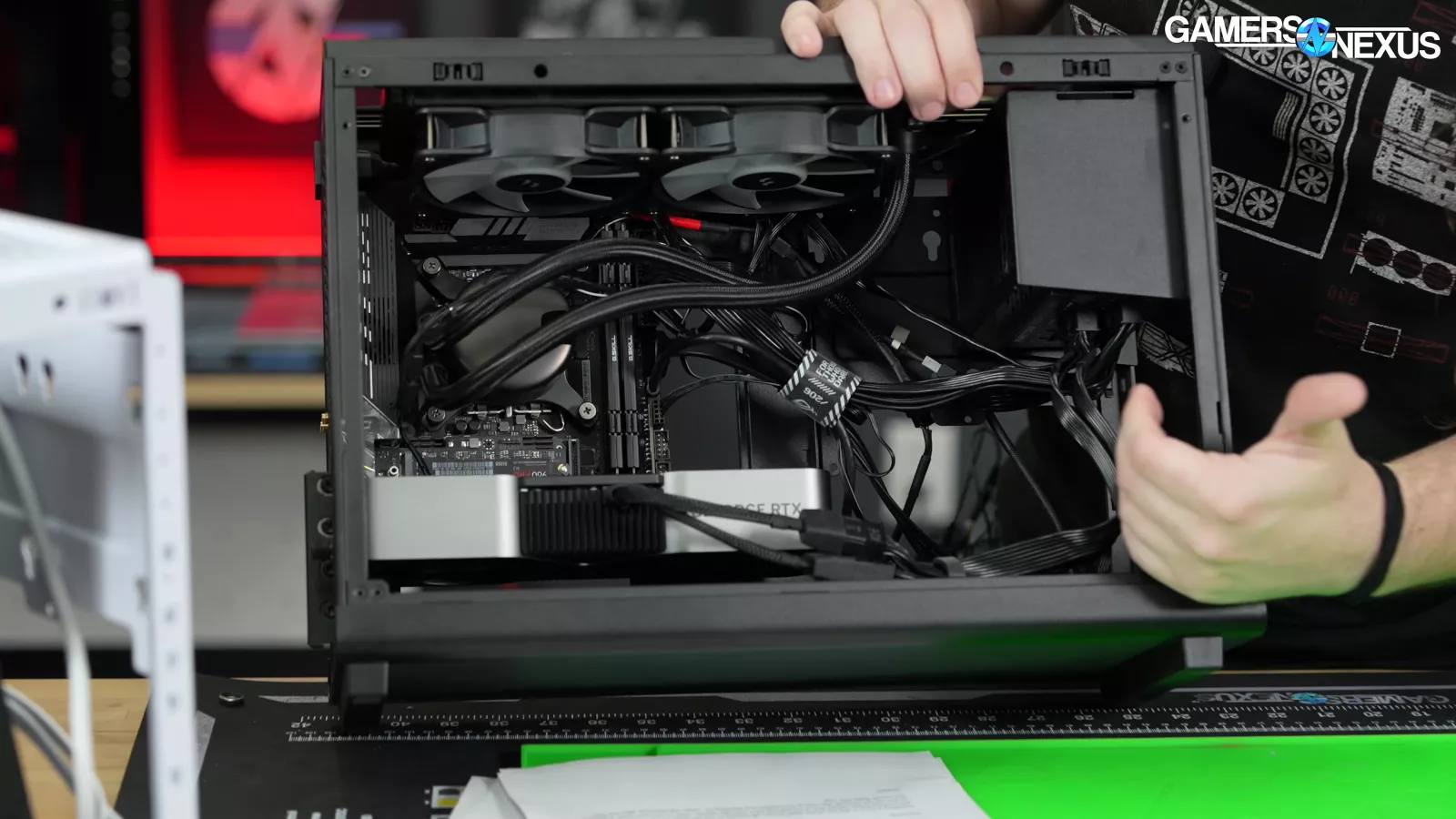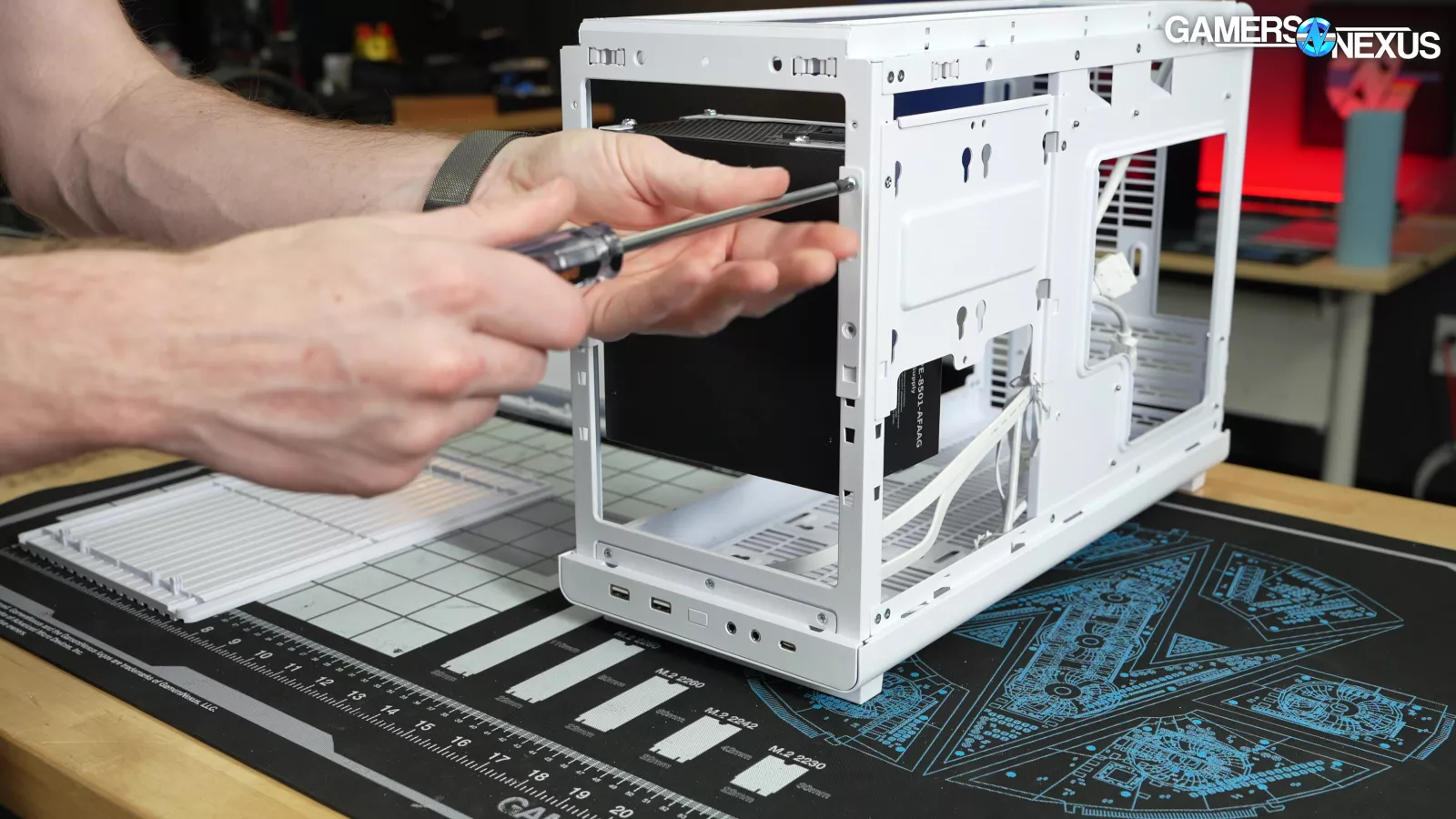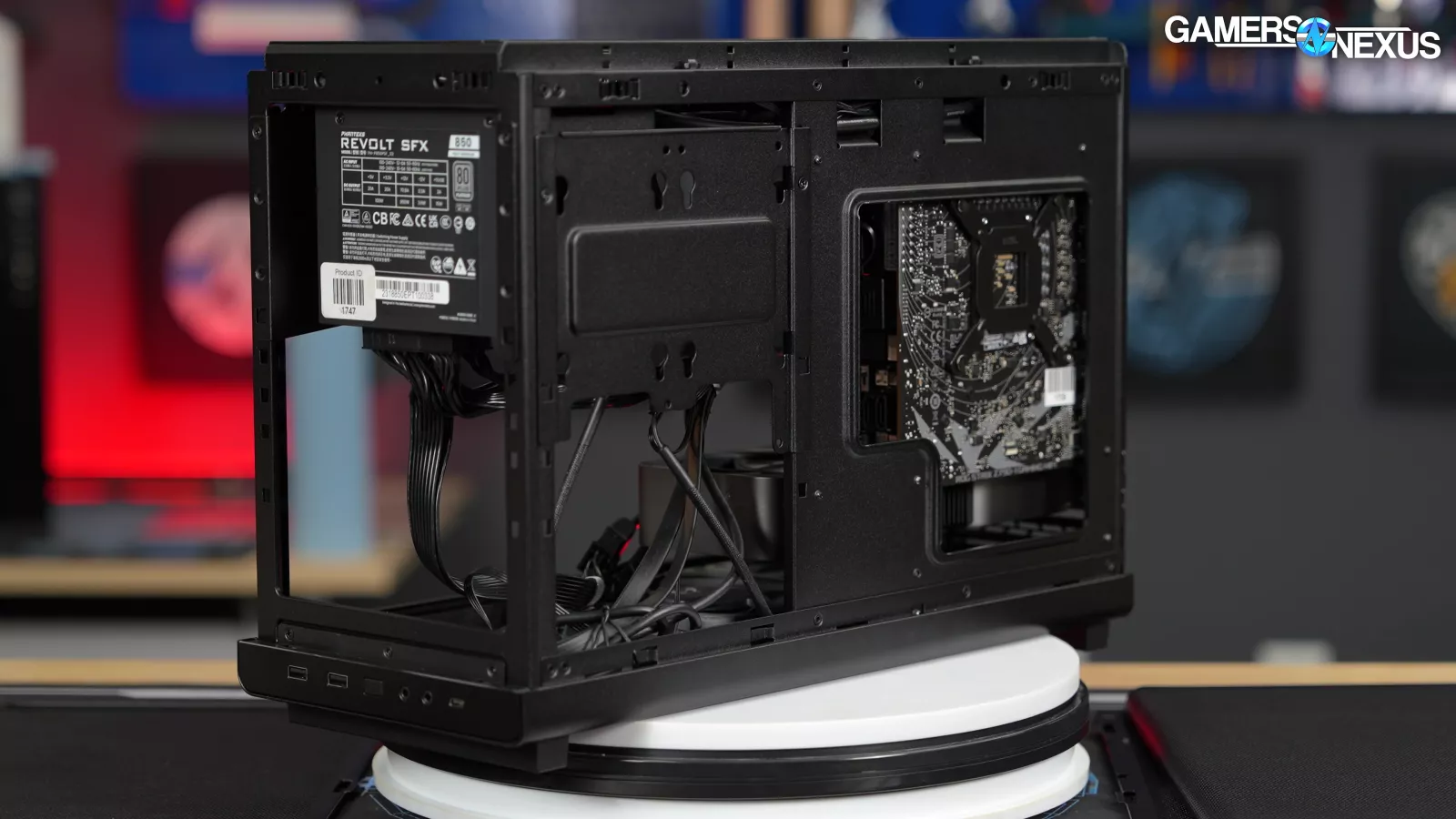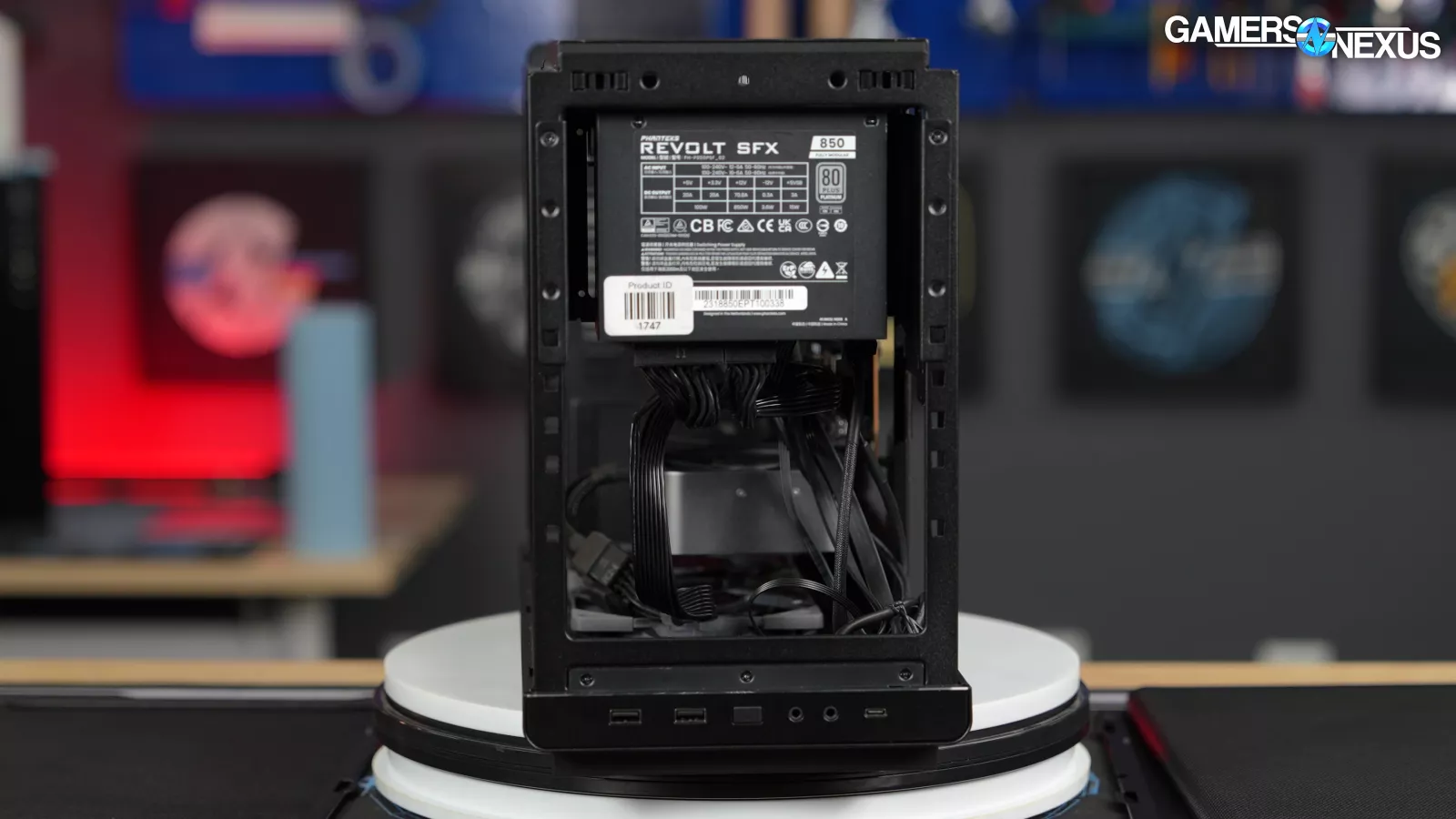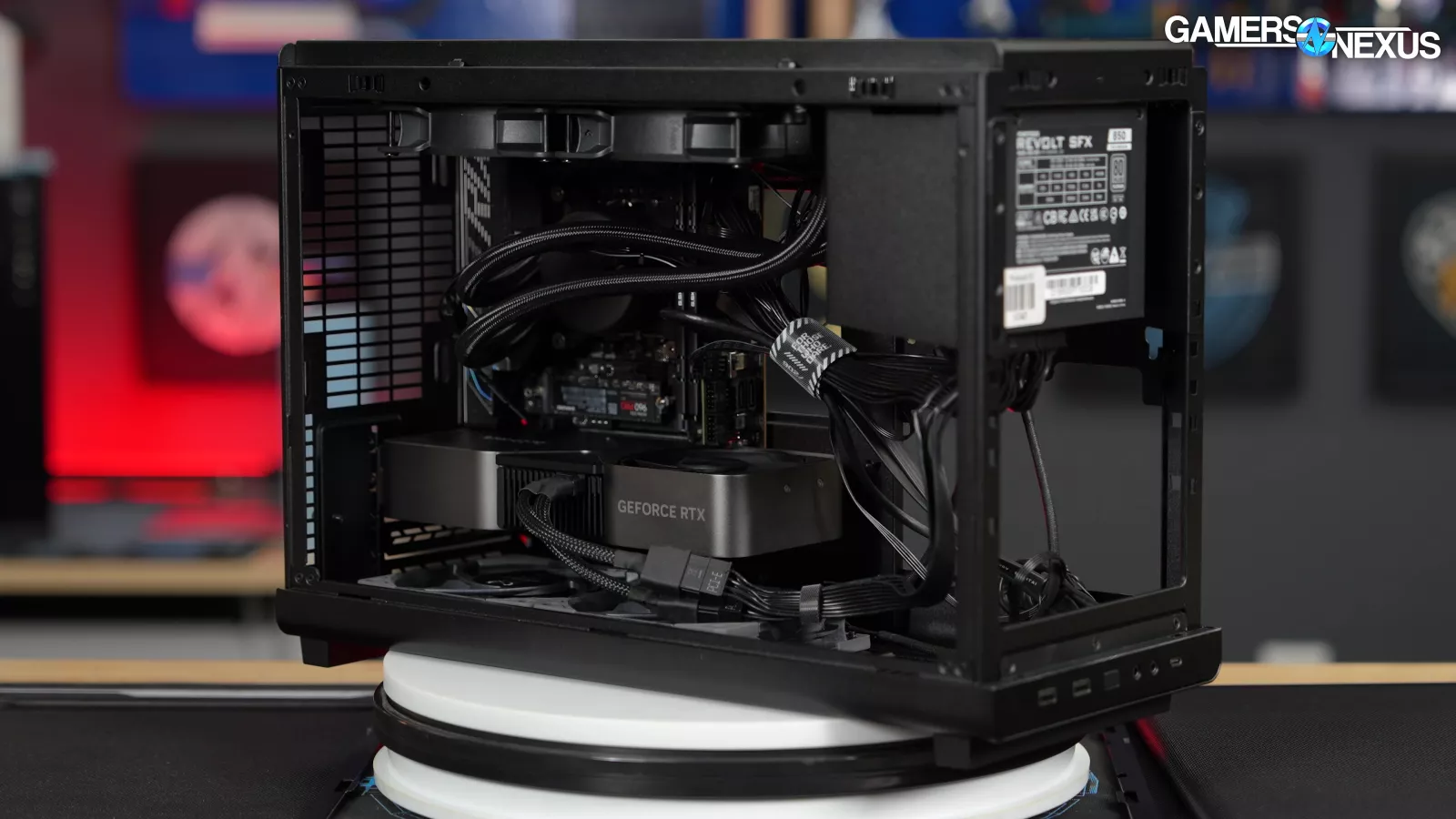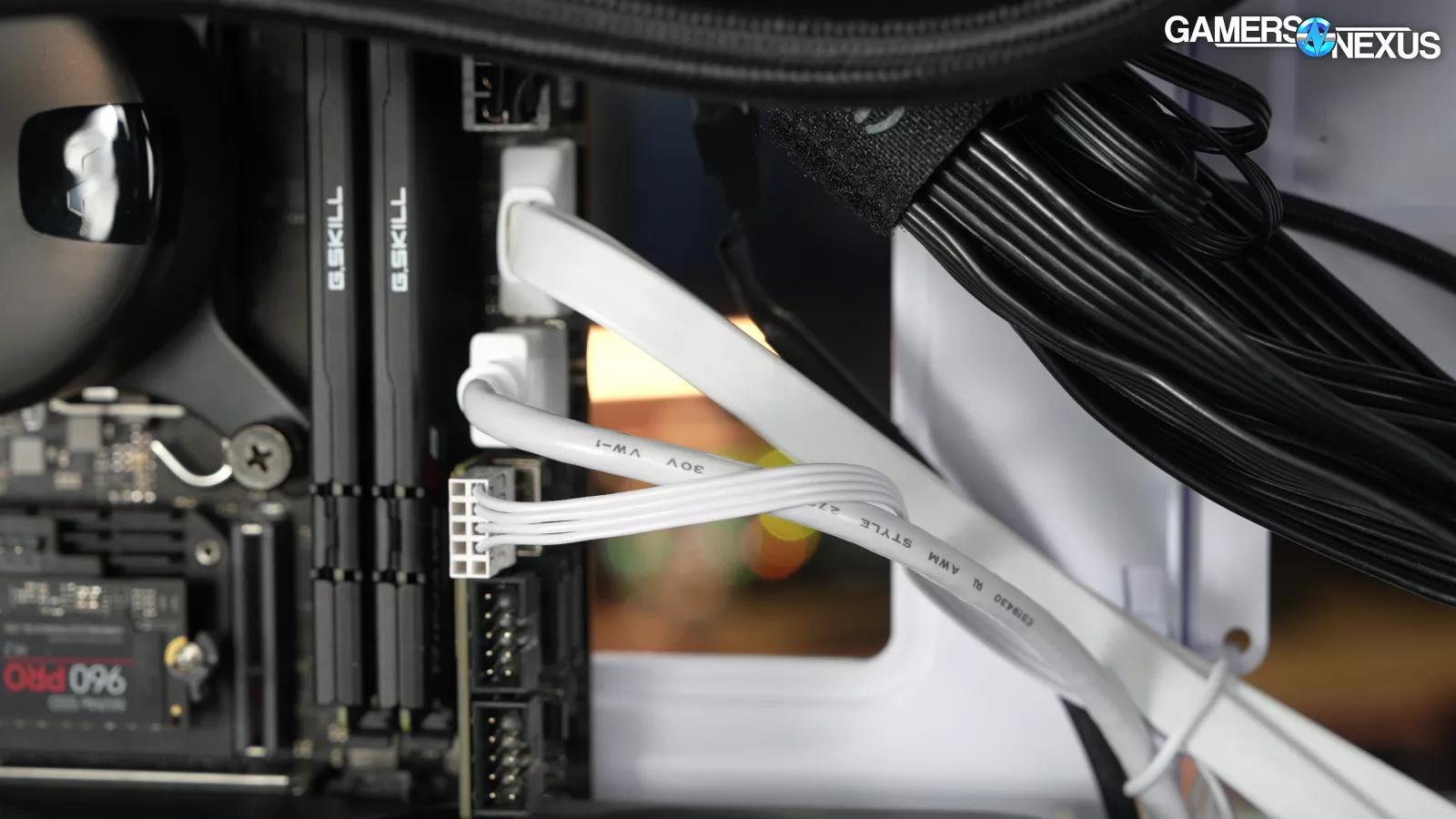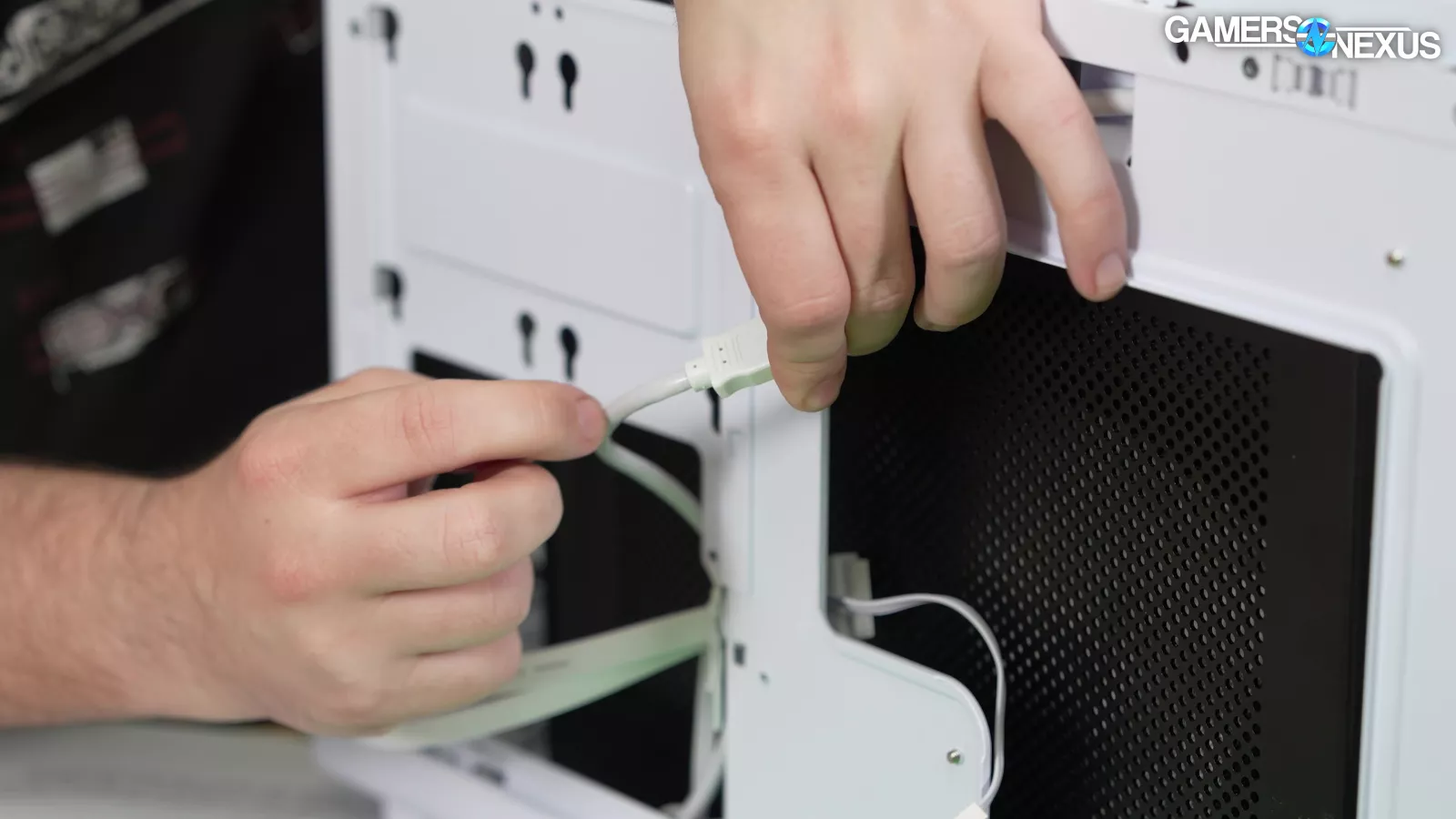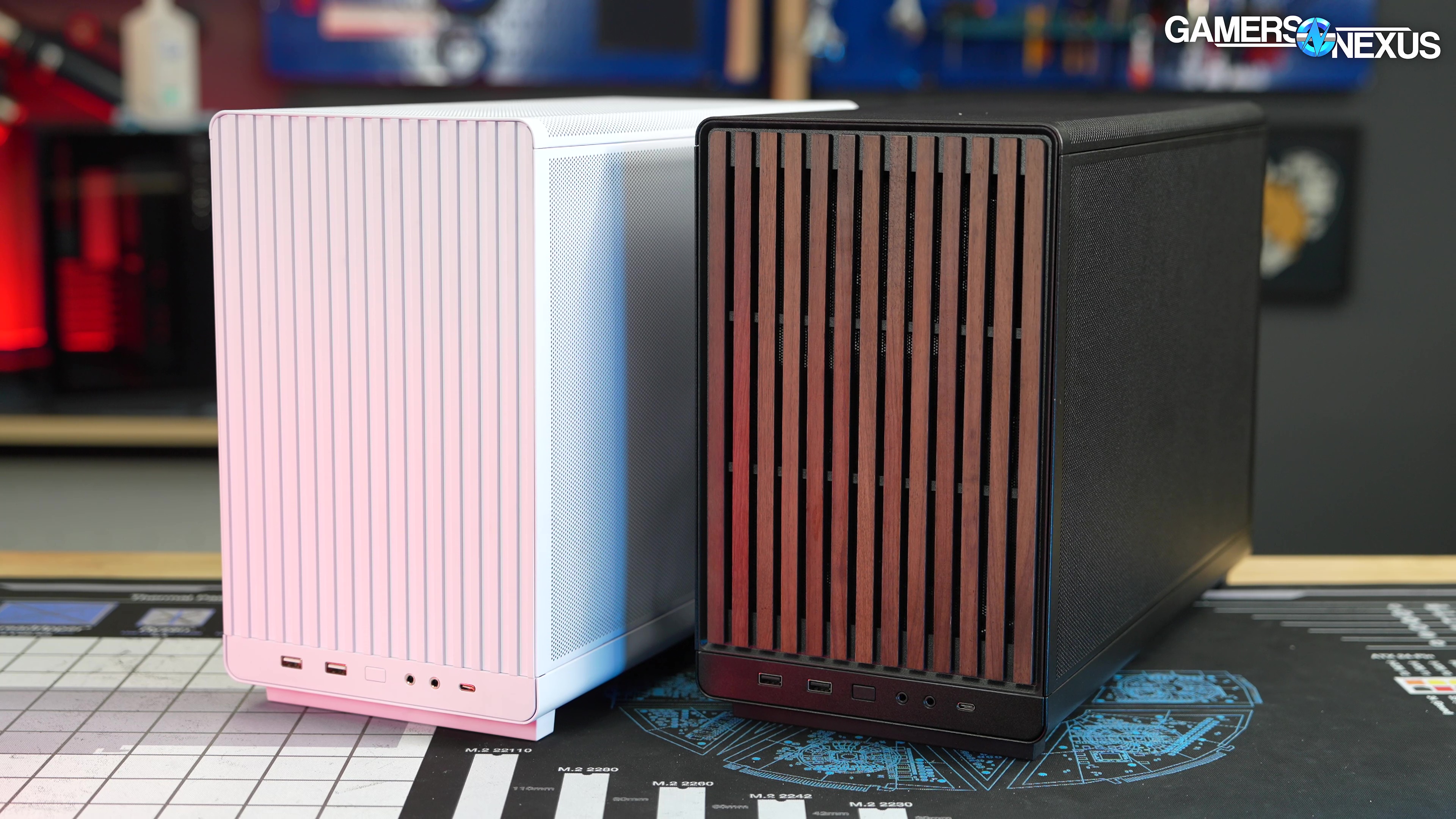
We test the Lian Li Dan A3-mATX-WD’s build quality, thermals, design, and more
The Highlights
- The A3-mATX is a micro-ATX case that offers either a plastic front panel or one with wood slats
- The case lacks good cable management options
- The A3-mATX is a good, affordable case that doesn’t feel cheap
- Original MSRP: $70 (plastic front panel), $80 (wood front panel)
- Release Date: May 2024
Table of Contents
- AutoTOC

Intro
We liked the A3-mATX enough that we made a custom 3D animation to help explain a peculiar airflow pattern that formed, where we found that adding side intake fans can dramatically hurt GPU thermal performance even though it helped the CPU.
But we liked the case because it’s easy to pull apart, heavily ventilated everywhere, has a huge amount of space in a relatively confined size, and it’s one of the most barebones interiors you could work with -- but in a productive way. It’s also $70 for the plastic-fronted version and $85 for this new Fractal-inspired wooden-paneled one. It ends up being one of the cheapest cases we’ve reviewed lately, which is good, because the budget market is still pretty strong with last-gen parts.
Editor's note: This was originally published on September 12, 2024 as a video. This content has been adapted to written format for this article and is unchanged from the original publication.
Credits
Test Lead, Host, Writing
Steve Burke
Testing, Writing
Jeremy Clayton
Camera, Video Editing
Vitalii Makhnovets
Camera
Tim Phetdara
3D Animation
Andrew Coleman
Writing, Web Editing
Jimmy Thang
And in spite of the $70 price for the base model, the case manages to avoid feeling cheap. The panels are solid and avoid that cheap, stamped steel wobble that you’ll feel on a lot of cheaper case panels. The top gets reinforced by radius at the borders, while the sides are reinforced with nearly 2mm steel along the inner edges. The only thing that really feels cheap is the original plastic front panel.
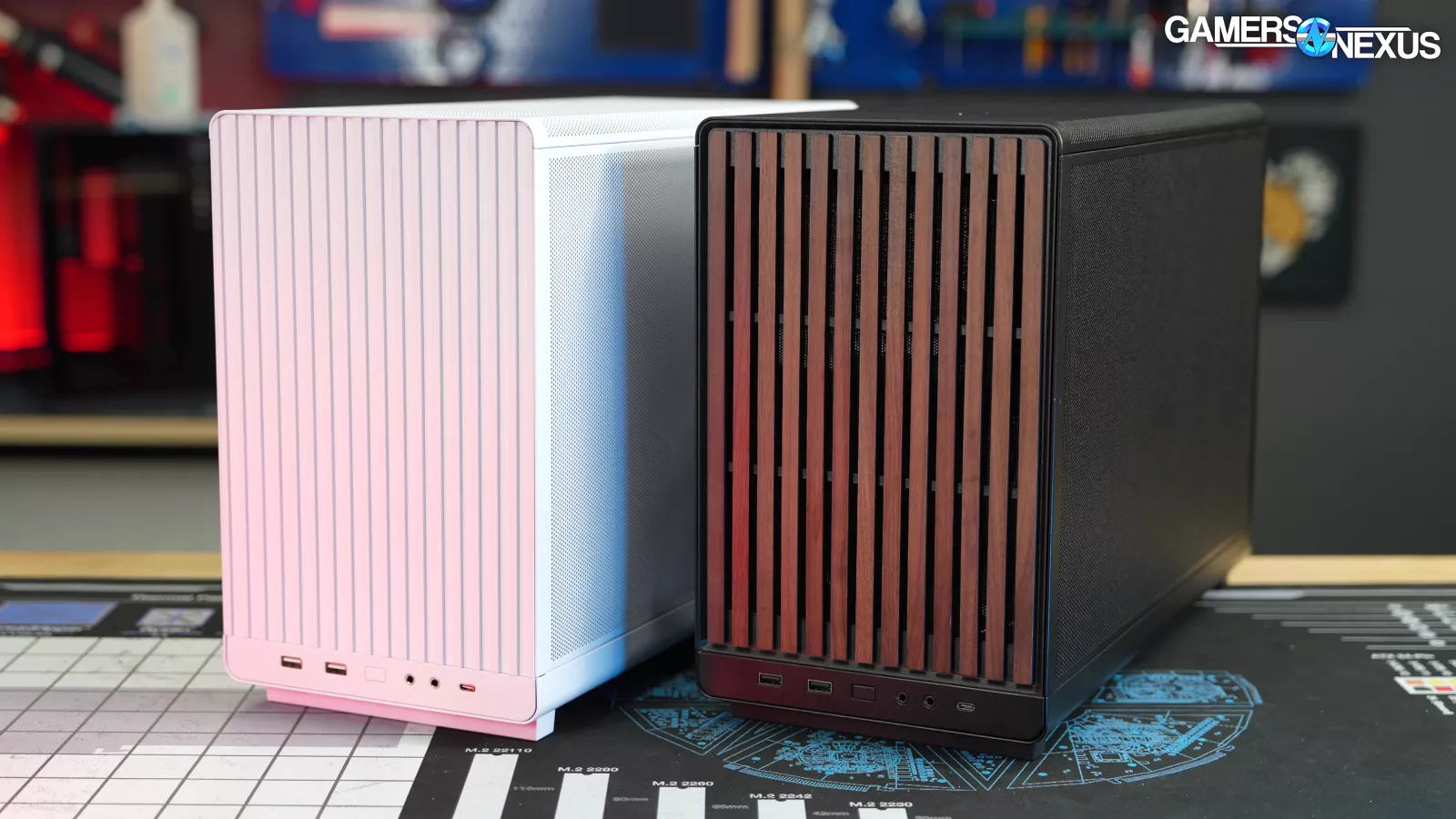
The above image showcases the case’s original panel (in white) against the newer wooden one. At a distance, the wooden one is almost indistinguishable from Fractal’s North styling. Beyond the wood slats, the panel significantly changes the front characteristics of the case by ventilating it heavily.
Going micro-ATX gives access to a broader range of cheaper components, but also means simpler mechanisms that are cheaper to make. Making a case like the Terra or NCORE 100 requires a lot of fine-tuning to fit everything, but mATX makes things simpler. Sometimes, that’s all we want.
A3-mATX Overview
The A3-MATX is clearly aimed at the budget market: It’s almost entirely stamped steel, has few accessories, and is generally a simple, empty box. It doesn’t include much other than the case itself and some screws.
There are a couple of optional accessories, but they’re all sold as DLC:
The new panel can be bought separately for $24 for those who already bought the original case, or $10 more than the price difference. There’s also a vertical GPU kit for $50 (which is a proportionally huge jump for a baseline $70-$85 case) and a glass side panel for $13.
We recommend against using both the glass panel and a vertical GPU at the same time, because the GPU would end up too close to the glass and will suffocate for air.
A3-mATX Competition & Alternatives
To get everyone up to speed, some of the price competition looks like this:
Fractal’s Pop Air Mini RGB is $60 on sale and includes 3 fans. This is a much larger case, but competitive on price and still mATX. Sama is a supplier in the industry, but also sells to consumers. Its ARGB Q5 is also $60 with 3 fans. They also have the IM01 Pro at $62 and the AR01-RGB at $70. Montech is selling its Air 100 mATX case for $70 with 4 fans, Thermaltake’s View 170 is also $70 with 3 fans, and ASUS’ AP201 is available at $75 without fans. Lian Li’s own O11 Air Mini is a large, more expensive alternative. Thermaltake’s Versa H18 would be another, this one at $55.
Compared to the preceding A4-H2O at $150, the $70-$85 price of the A3 is aggressive. That’s true too of the SSUPD Meshroom D at $100. Both the A4 and Meshroom are also manufactured by Lian Li, but are limited to ITX motherboards.
A3-mATX Basics
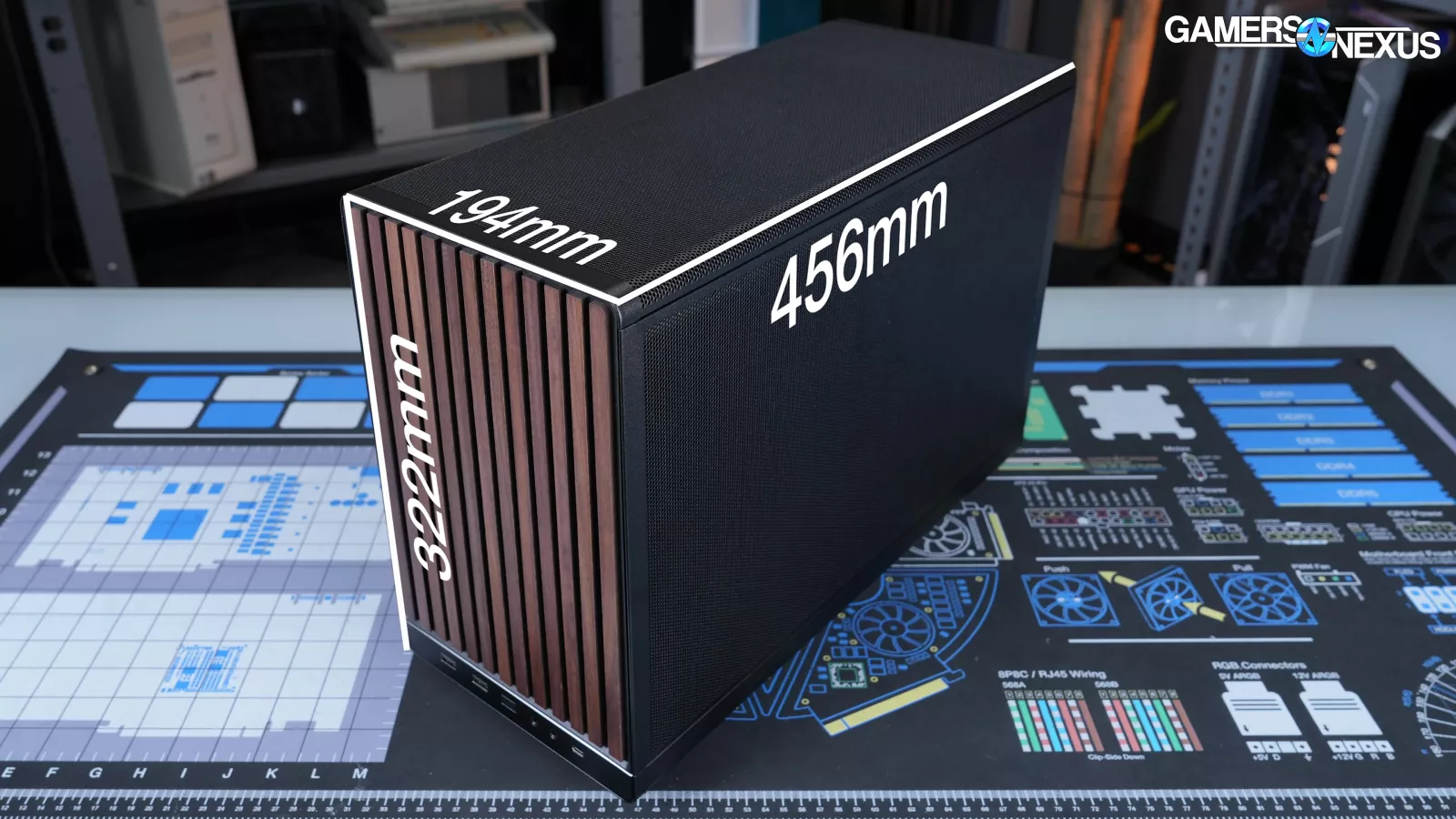
Dimensions for the A3-mATX are 456x194x322mm, coming to 28.5L in volume – larger than the claimed 26L due to the usual suspects of rear protrusions and the case’s feet.
The A3-mATX is heavily ventilated across the entire chassis, including the top panel, both sides, and with the wood model, also the front. The back also has large gaps in its ventilation for another fan mount, with even more holes punched out of the bottom.
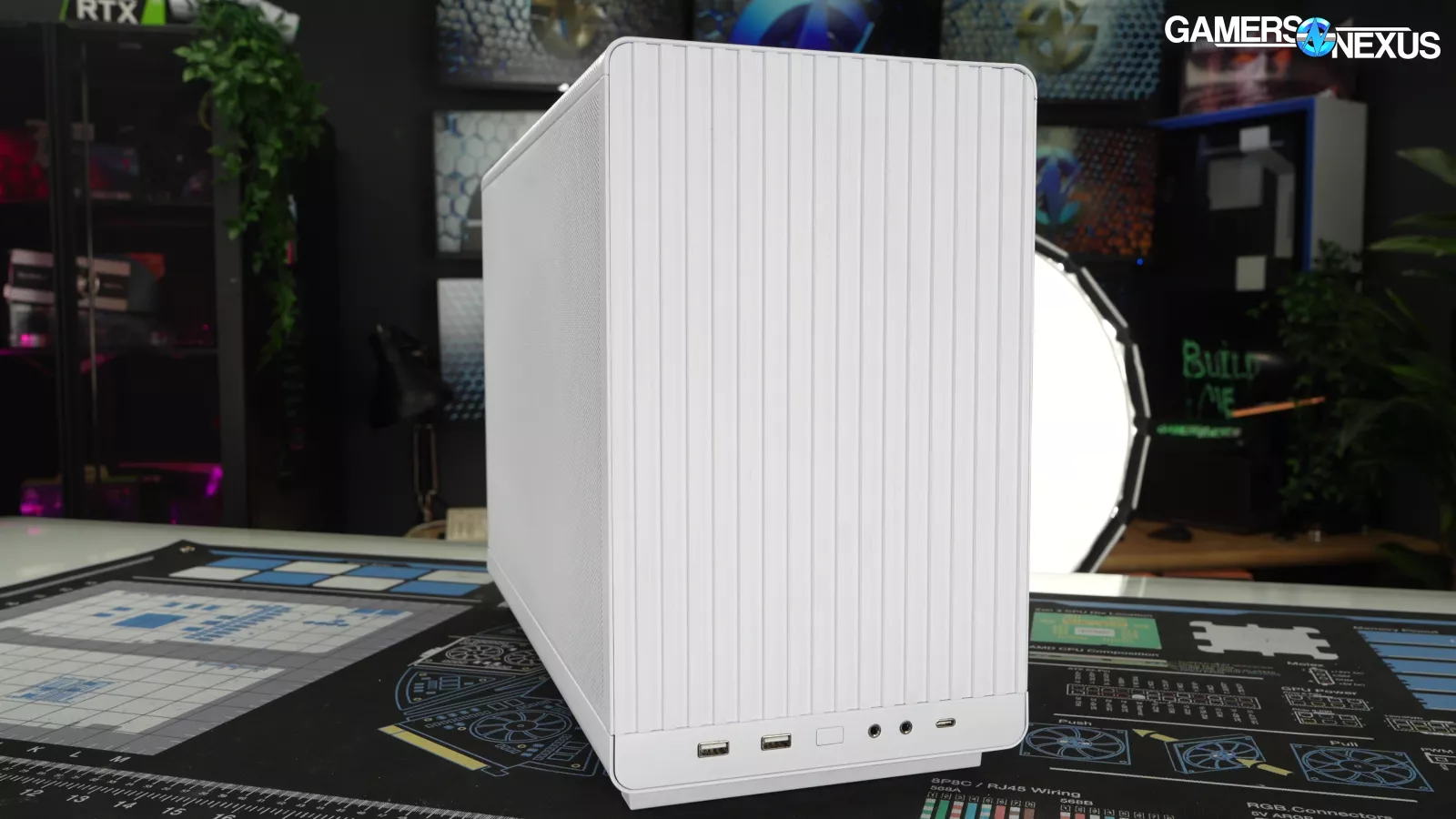
The only truly solid panel is on the non-wood variant with its front panel.
The A3-mATX technically has 10 fan mounts, but some configurations force giving up one or two fans depending on the location of the PSU mount. Lian Li lists support for 360mm liquid coolers in the top, bottom, and left side – more on that bracket later. If you put a closed-loop liquid cooler in the floor with its pump in the CPU block, that pump will be much more likely to die. The liquid needs to be above the pump so that air doesn’t collect in the pump itself. The bottom could still be useful for open loop radiators or for pump-in-rad and pump-in-tube designs.
We also noticed that some motherboards may collide with 140mm-wide top-mount radiators when coupled with fans.
The case also comes with side mount options. We actually observed that the side mount makes it possible to worsen GPU thermals in a way that may seem counter-intuitive, so let’s explore that.

We’ll get ahead of ourselves for the thermal testing later in this review. Here’s a chart showing the side configured with 2x intake fans and a top-exhaust liquid cooler as compared against just the system with just top exhaust (no extra fans) and against 2 bottom intake fans with top exhaust. This is with the plastic front, not the wood front. We’ll get to that later.
The impact to GPU thermals is massive. We measured about an 11-degree drop in average GPU temperature by getting rid of the side intake, extra fans. To help make this easier to understand, we made a custom 3D animation and we’ll come back to thermals later.
Our animation explains what we think is happening. When the system is configured with only the top exhaust fans, the system is in a negative pressure setup. In PC building terminology, this means there is more forced outflow through fans than intake, from the perspective of the case. As a result, air will naturally find its way in through effectively every hole in the case, but especially the two closest ones: The large, empty fan mount in the back and the empty mesh on the left side panel. This air flows straight in and out the liquid cooler through its fans.
As for the GPU, its fans are close to the bottom and to the unused PCIe slot covers in the back. This is where the GPU will pull its air in, so it will be fed cool exterior air within mere centimeters of the outside of the case. That’s great for the GPU.
When we add two side intake fans to this configuration, especially two which will have greater pressure than the exhaust fans, everything changes. The exhaust fans are already battling resistance from the radiator, so the two side intake fans will end up creating a new pressure system. Now, air immediately outside the mesh side panel will find itself pulled toward the fans and shot into the case above the GPU, which will greatly benefit CPU cooling in our tests later. The downside of this is that the lower third of the side panel that was previously feeding the video card intake is now less utilized for the video card, and instead, most of that air will move either directly into the fans or will draft into the case and be pulled up by the currents. The end result is that most of this lower-third side intake no longer feeds the video card, suffocating it for air.
Instead, the video card is left to pull only from the bottom. It also isn’t pulling air in through the PCIe slot covers anymore and will instead be exhausting air through them as a result of the pressure change. There is more resistance for air to come in than for air to go out, so it will naturally want to find its way out of the computer in that region. Likewise, the flow-through of the GPU is now facing a pillar of air coming in, which will reduce the speed at which it can exit this area of the case.
If we remove those two side fans, the original layout allowed a straight column of air to form from the flow-through fan to the top exhaust fans, efficiently removing air from the middle ground.
And as usual, all of this type of testing is heavily dependent on the other components within the case. Your results may vary with different fans, a different video card, or a different CPU cooler. For purposes of why the thermals behave the way they do in our configuration, the above explains it.
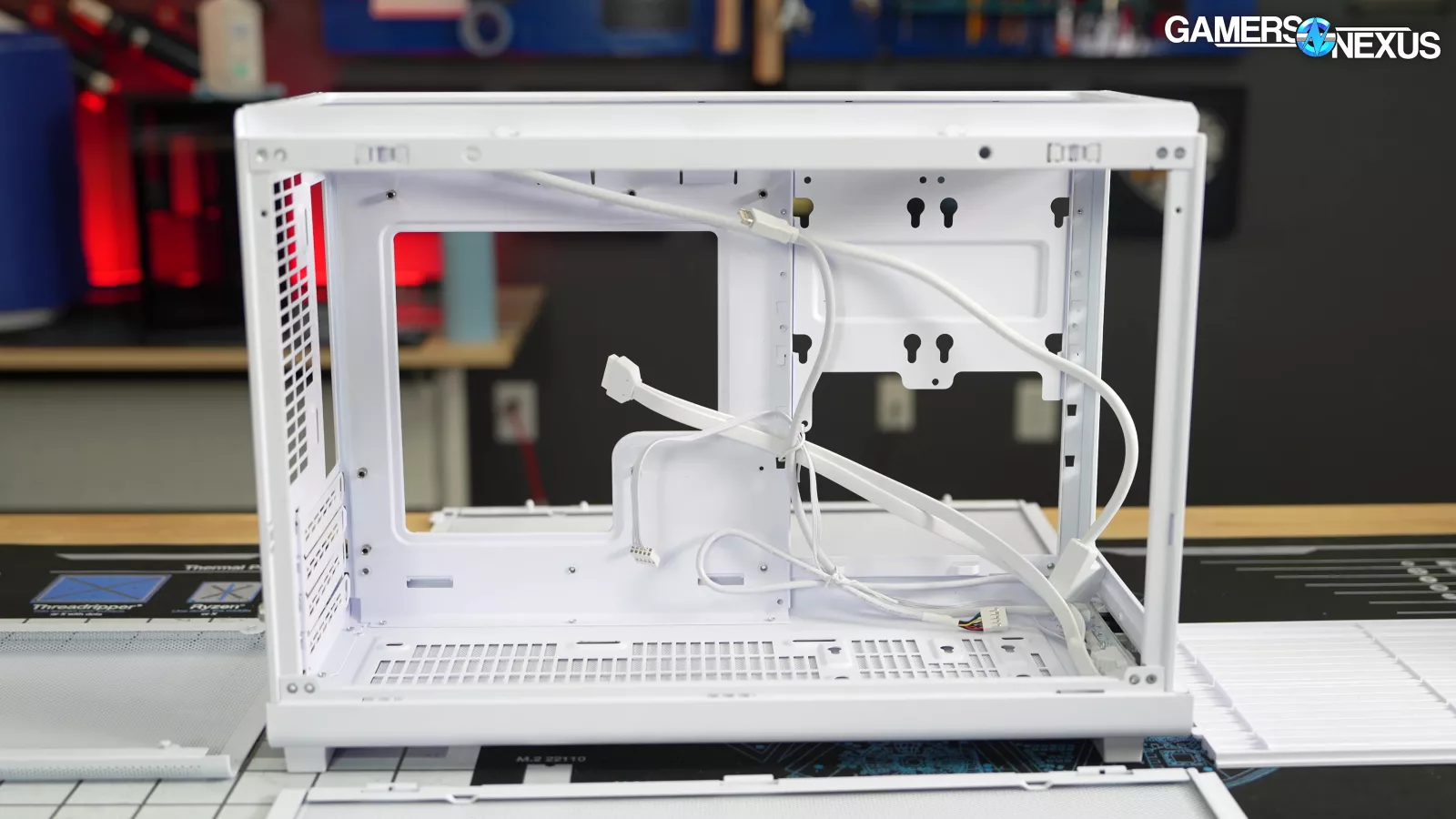
The empty layout and relatively large area allows a lot of different air and liquid cooling configurations. This isn’t a true successor to the A4, but it doesn’t appear to be intended as one. It’s doing something else.
Internally, there’s enough space to install a custom water cooling loop without going completely insane from fitment issues – maybe even with dual 360s. It also fits much larger modern video cards. And, of course, it also brings the price floor down because microATX boards are often pretty cheap.
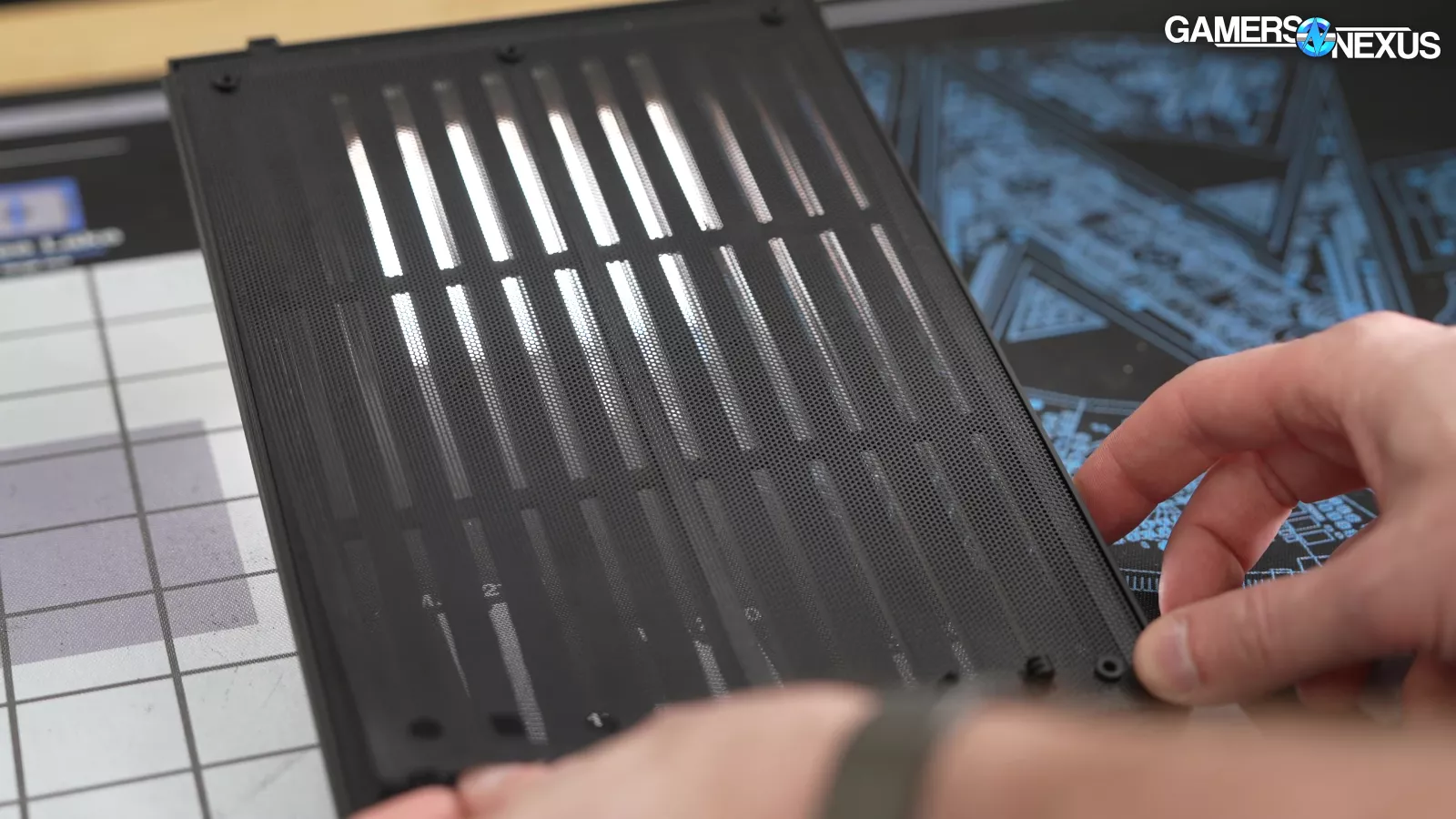
Moving to the front panel, the wood version has an easily-removable dust filter retained with magnets. There’s no extra fan mount in front with this new panel, though even if you forced one to fit, most of the mesh is obstructed by the wood. It’s best to view this as a passive area of flow.
Coming back to the power supply, the case can support SFX and ATX PSUs up to 220mm long on the right or front walls using a slightly clumsy mounting bracket. The vertical rails alternatively support an SSD bracket. There’s also a strange optional way to mount an ATX PSU to the SSD tray using standoffs. This extreme flexibility results in such a complex web of component compatibility that Lian Li created 9 entire tables for it, separate from the manual. All of this was done without a mess of complicated and customized hardware and brackets thanks to the departure from a tinier ITX box.

GPUs up to 4 slots thick and 415mm long can technically fit, depending on where and how long the PSU is. However, when using a GPU this large, be advised that it will effectively cut the case in half and severely change the airflow patterns. The GPU will only be able to pull from the bottom and rear PCIe slot covers, meaning side intake will significantly hurt its performance. When using the vertical GPU bracket, that’s reduced to 3.5 slots and 355mm in length. Again, we’d advise against the glass panel for a vertical GPU configuration. This would also reduce CPU cooler access to air.
The optional vertical GPU mount is good and bad:
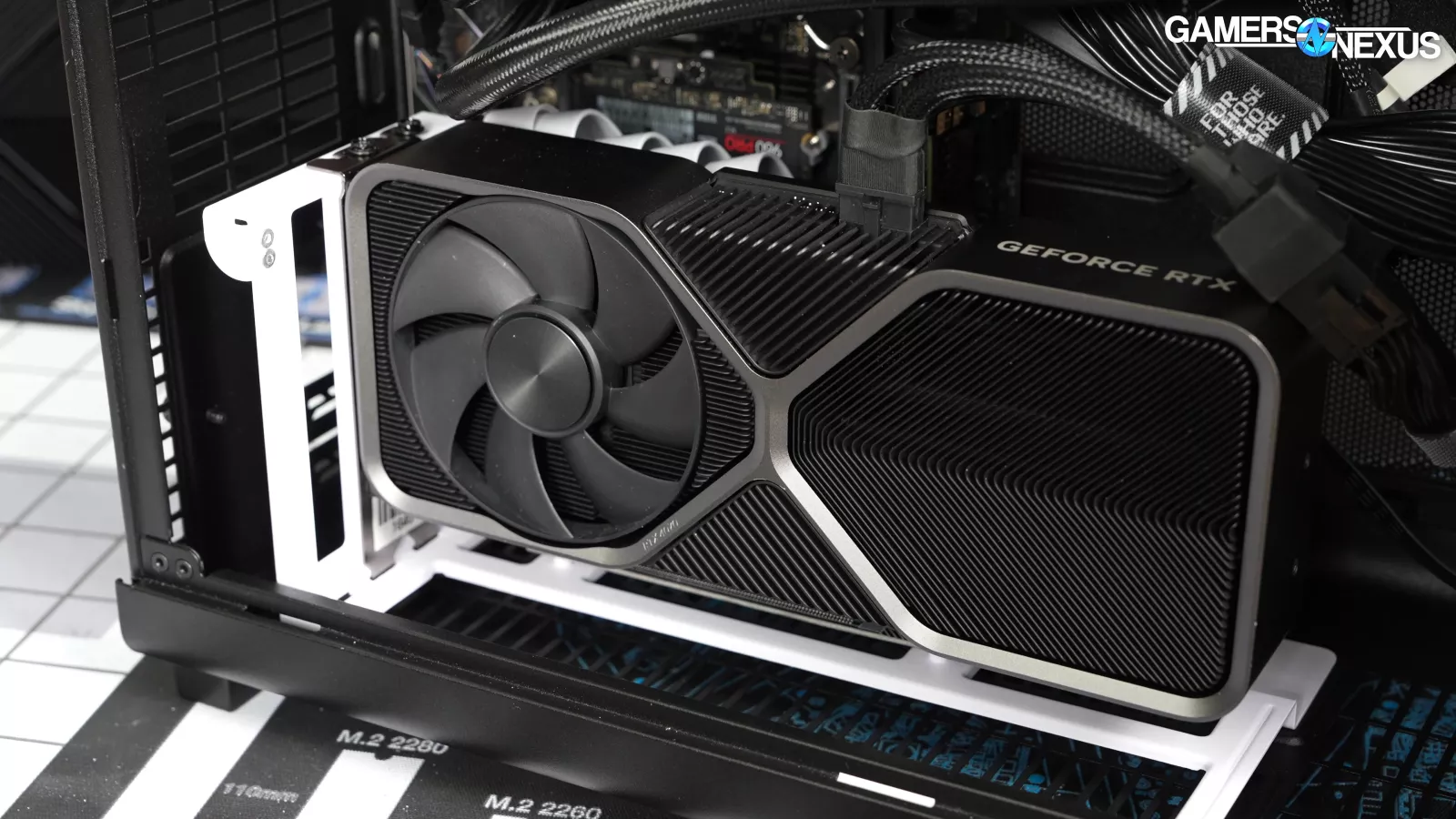
On the good side, it’s a pretty universal and easy-to-install design that looks like it could be used in more than one case, as it attaches to the bottom fan mount locations, which are standard 120mm spacing.
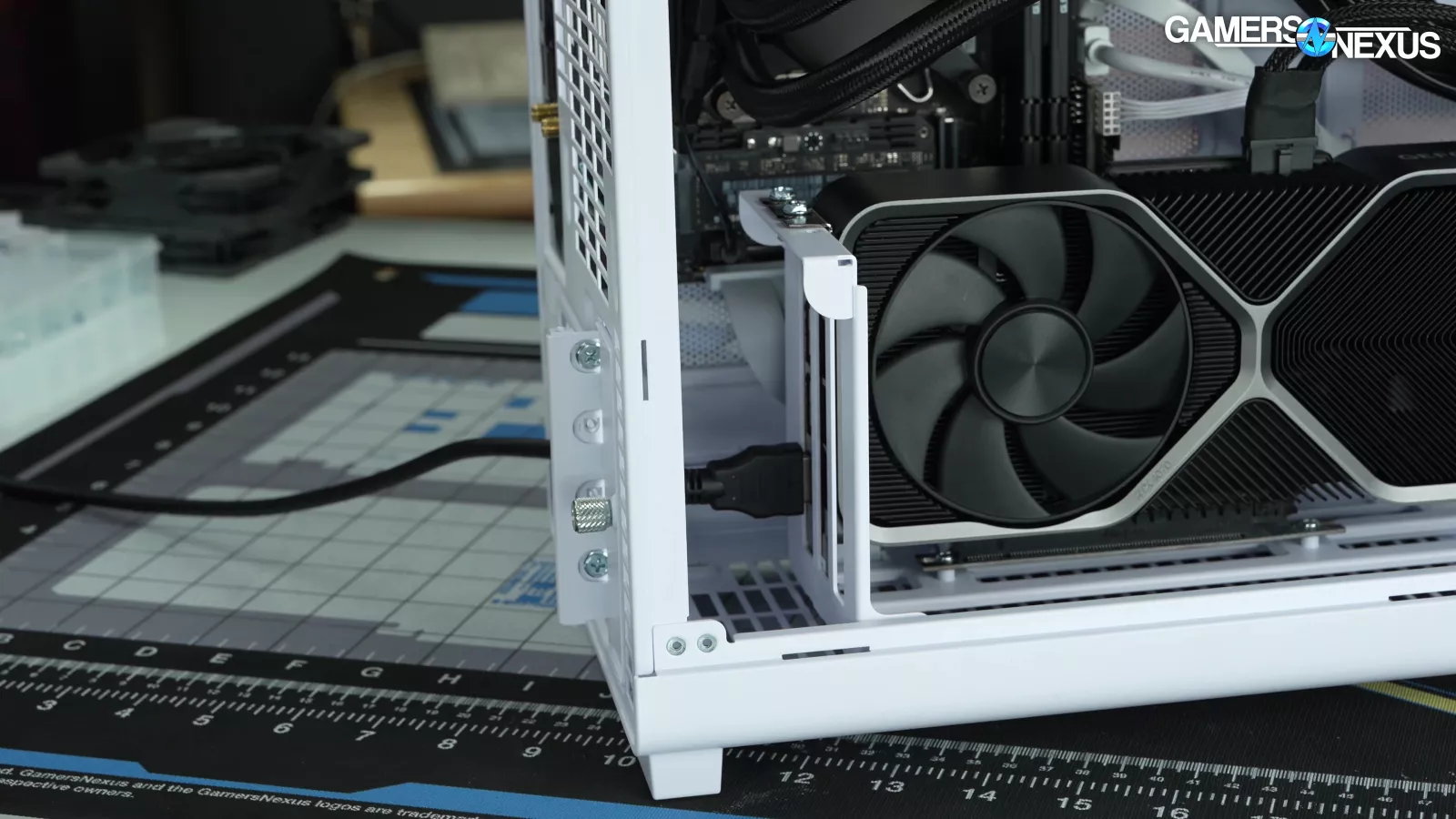
On the bad side, we think not integrating into the rear I/O of the case itself is a sub-optimal solution that makes plugging or unplugging display cables an annoying operation, even with how infrequent that is in normal use. It requires removing the left side panel and fishing it through the replacement PCIe bracket grommet. Unfortunately, the pass-through doesn’t line up with the GPU itself, making it that much more awkward. It does work, just not well.
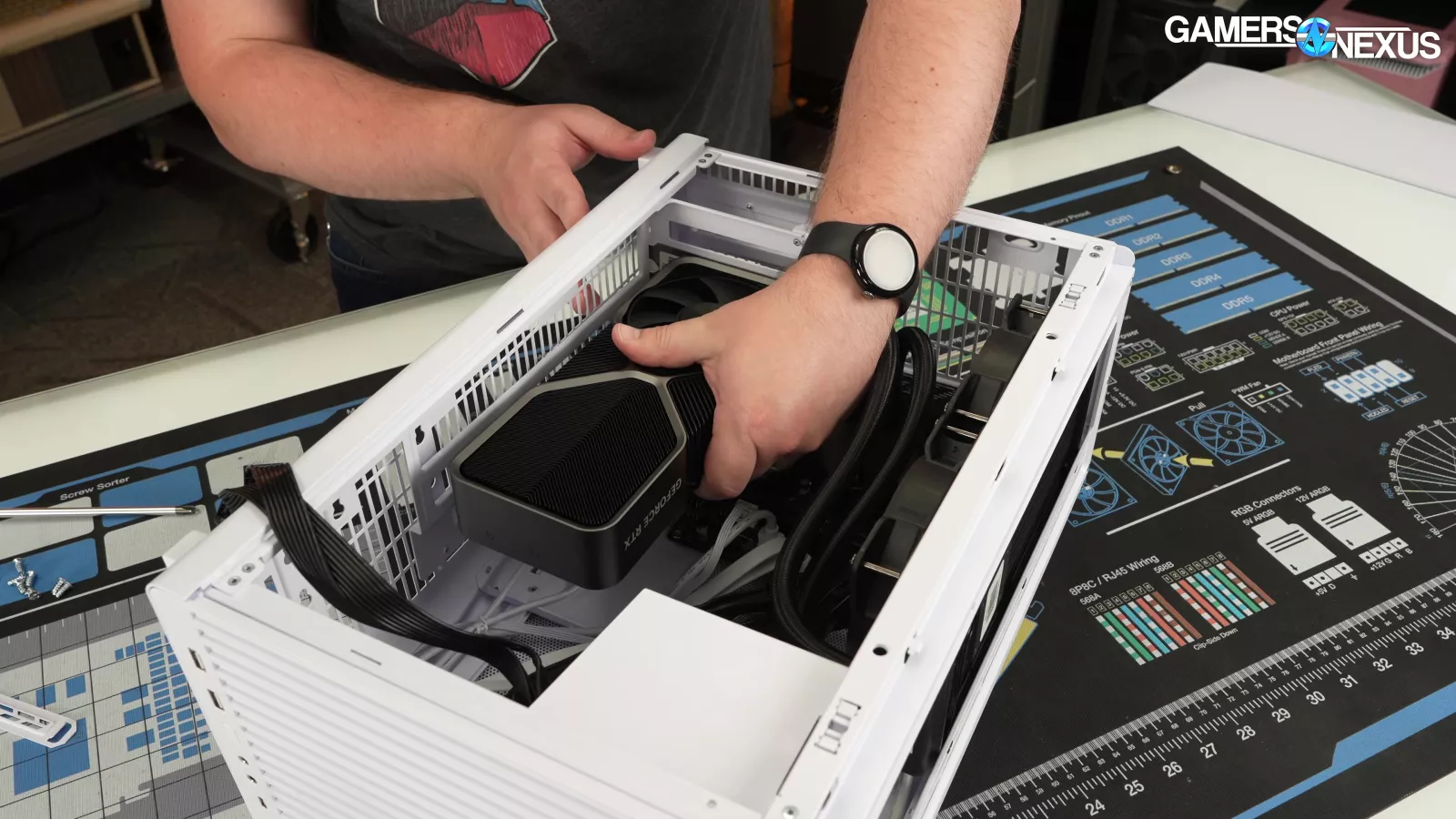
NVIDIA 40 Series Founders Edition cards have no problem fitting inside. The ASUS Strix 4090 fits, but would require careful consideration to not put pressure on the power connector. The massive Gigabyte Aorus Master just barely doesn’t fit due to how tall the card is around the PCIe bracket. But just because it fits doesn’t mean it’d be a good combination for thermals, and we’d recommend against any cards of that size in this case.
The Build - Positives
Despite the clunkiness of the SSD and PSU mounting solution, we like how the tabs at the bottom keep them in place while securing the top with screws, and found the design simple and functional. There’s an additional 3.5” or 2.5” drive mount in the front floor of the case, but using it blocks off the forward-most fan mount.
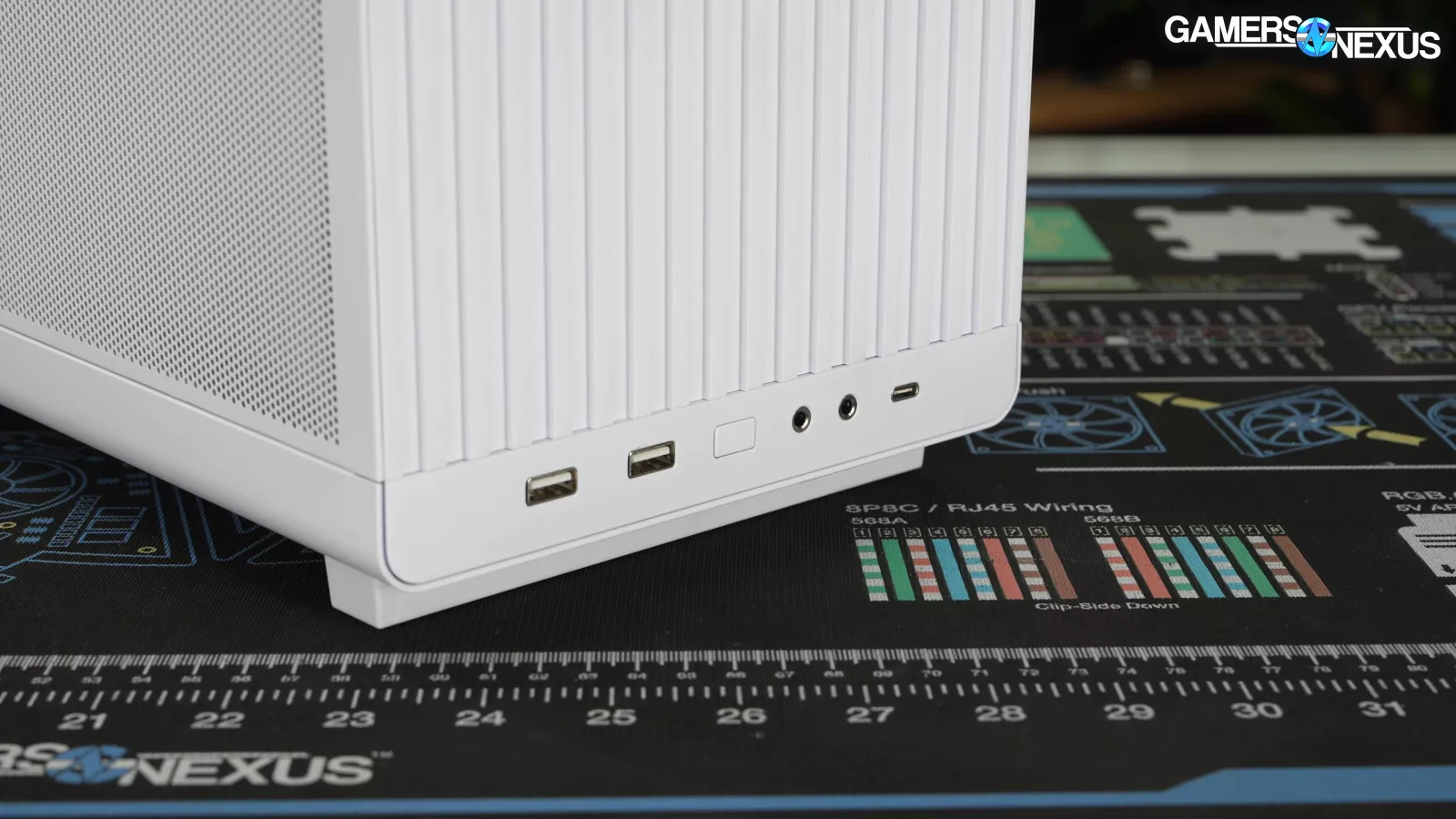
Front I/O is good: It has 2x USB-A, 1x USB-C, and separate mic and headphone jacks – something we prefer over single combo jacks.
A3-mATX Cable Management
Cable management in general is a weak point. The cable management solution appears to be “it’s huge, so put them wherever.” It isn’t as crafted as some of the competition.
There are no channels or covers and there isn’t really any space behind the motherboard. Tie-down points are limited. We’re left having to just bundle most of them up into a clump.
Similarly, the front panel USB 3 cable is short enough that it could pose some clean cable management challenges when using a mini-ITX motherboard depending on where the USB 3 header is, but it wouldn’t be a problem with mATX.
Installing a CLC in the top of the case blocks off access to the top edge of the motherboard, so pre-running those cables first is something we’d strongly advise. This could have been mitigated by the top fan bracket also being removable and allowing for cable adjustments after the fact, but would likely add cost.
White is known in the industry to be a challenge for color matching across materials. On the white version, the color doesn’t match across some of the internal cables, connectors, and the AC power plug on the rear of the case.
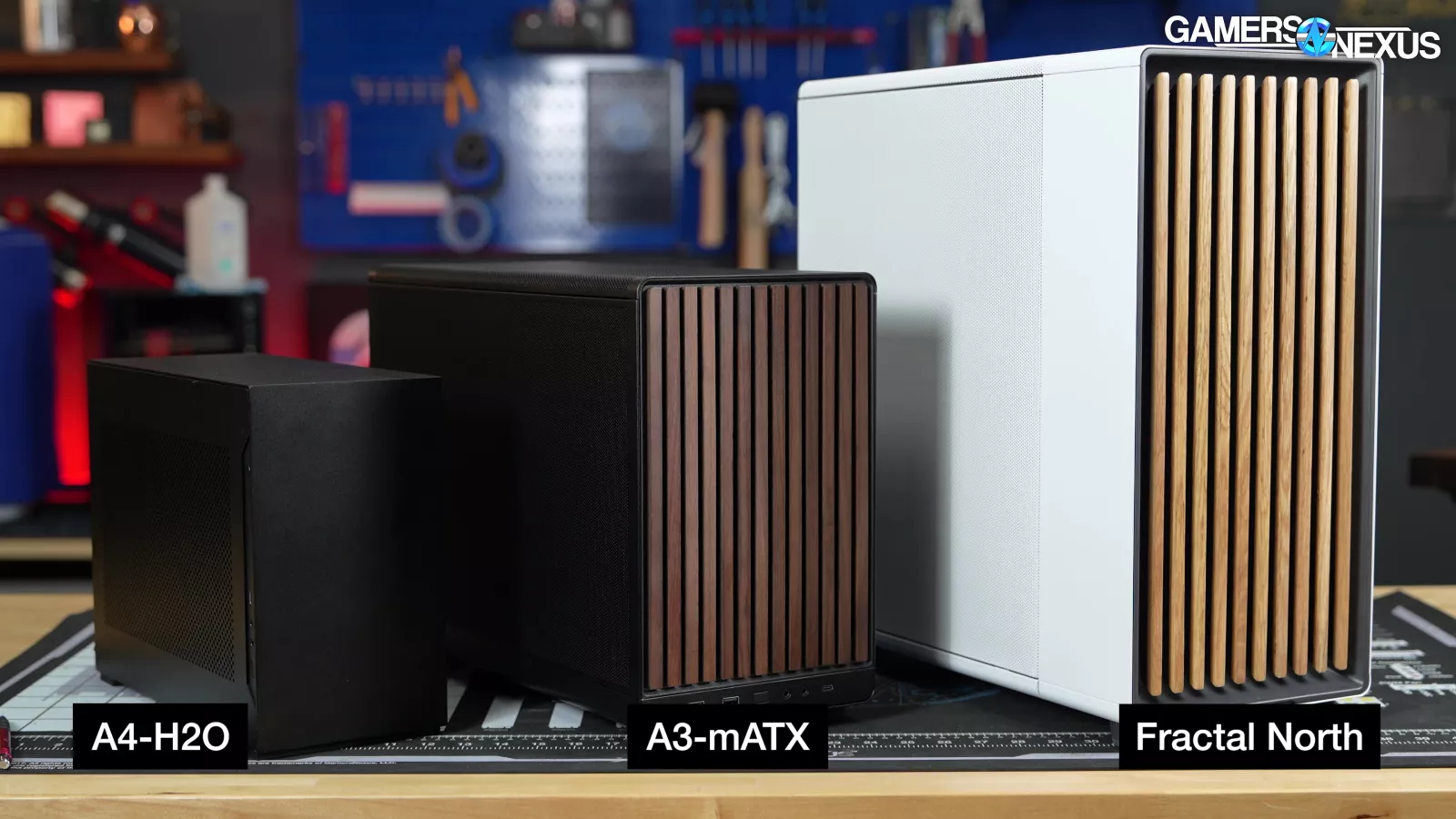
This combined with the competition in the mATX case market pushes us towards favoring the wood version – it at least doesn’t feel cheap. You also got a little bit of a visual flair without going up to the price levels of something like the Fractal North.
Time to get into thermals.

A3-mATX Thermals
All tests were performed with a Fractal Lumen 240mm closed loop liquid cooler with the pump and fans set to 100%. Any tests with additional fans also have those at 100%. The 4070 FE (watch our review) has its fans controlled for all tests.
CPU Thermals - Full Torture
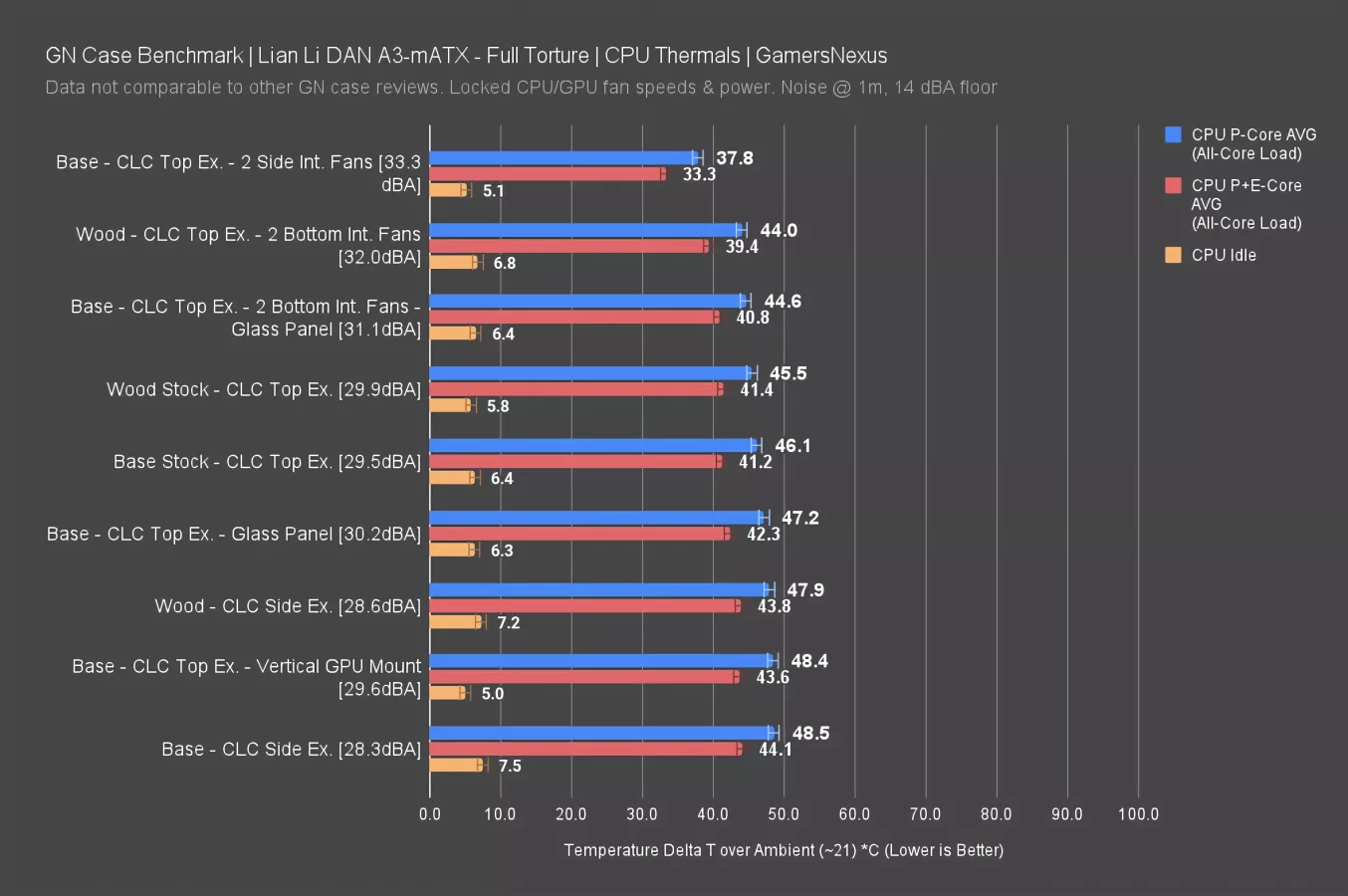
Here’s the CPU full torture thermal chart.
In this testing, baseline stock testing between the wood panel and plastic panel ended up about the same: 45.5 and 46.1 degrees over ambient for those means they are within error of each other. Testing the base model with a top exhaust CLC and 2x side intake fans boosts its performance massively, with a huge gain over every other configuration. The side fans really help the CPU cooling, despite hurting GPU cooling.
The second best P-core average thermals come from the wood front panel version with the CLC in the top as exhaust, and two intake fans in the bottom. This results in 44C over ambient, with noise levels only marginally raised over the base version with its solid front panel and glass side panel.
It’s clear throughout the results that the wood front panel with its open mesh areas lets slightly more noise escape the case in general. The thermal data leans slightly cooler for like configurations as well, but both the thermal and noise results are indistinguishable and mostly fall within margin of error.
Removing the two case fans puts the case in “wood stock” configuration, which is 1.5C warmer and not bad, all things considered. Other configurations filter in below, with the base vertical GPU mount and CLC side exhaust setups coming in last at about 48C over ambient.
GPU Thermals - Full Torture
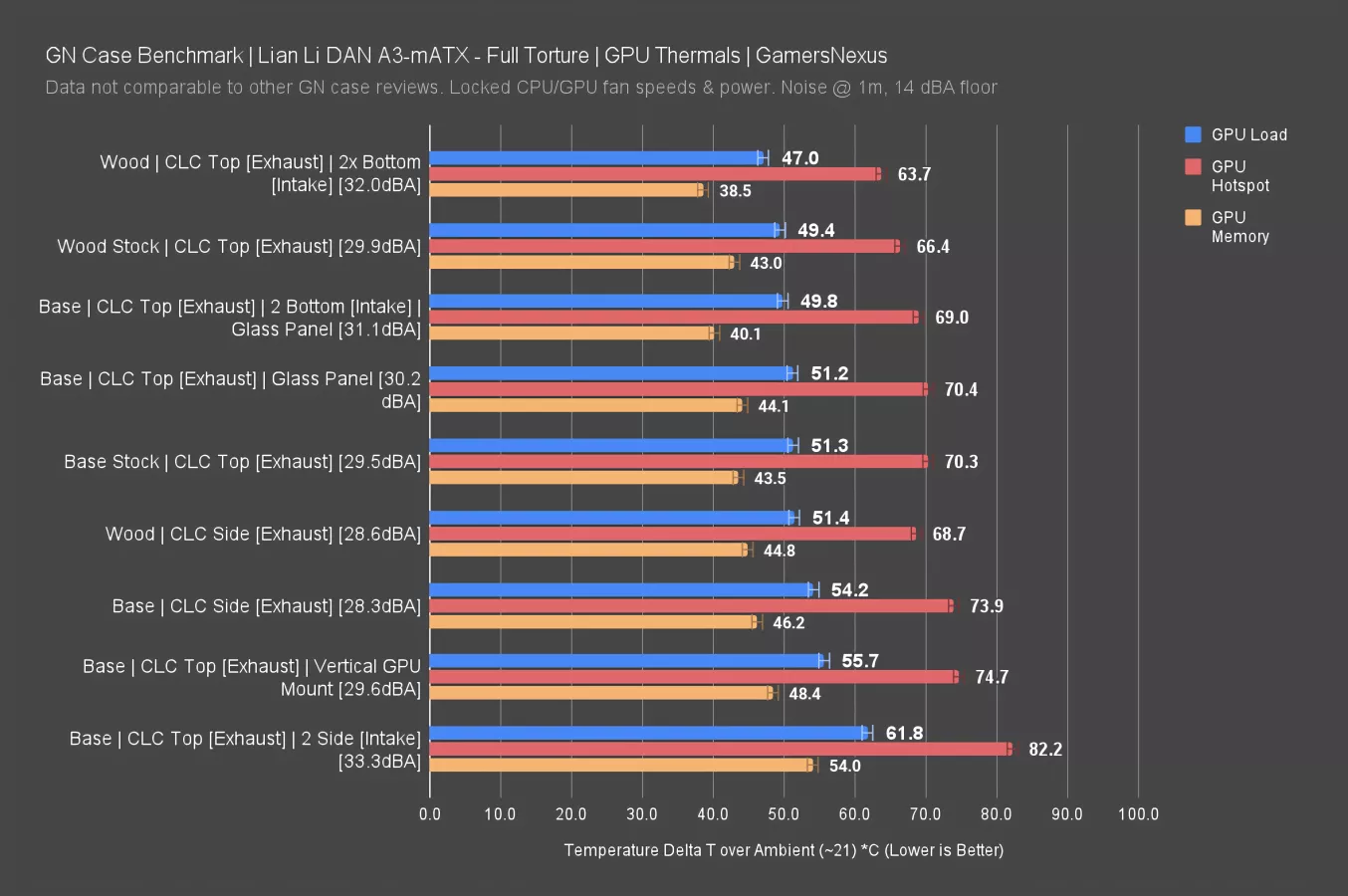
For GPU thermals, the top non-problematic result from CPU thermals is now the leader in GPU thermals at 47C over ambient. Considering the reasonable 32dBA noise level in our hemi-anechoic chamber, we’ll point to this configuration as the way to go unless your aim is to minimize noise as much as possible.
Bottom-mounted fans benefit the GPU, unsurprisingly, with the result at 47 degrees GPU core. We see another appearance at 49.8, showing that the glass panel costs us a couple degrees in this layout.
Mounting the CLC to the side as exhaust shows an interesting 3C split between the wood front and base versions of the case, favoring the wood.
Unfortunately for vertical GPU enjoyers, that configuration was one of the worst results if not counting the troublesome side intake configuration we talked about earlier. We suspect recirculation is to blame for parts of this, as the exhaust coming out of both the PCIe slot area and the flow-through area don’t have easy paths to get out of the case naturally.
RAM and VRM Thermals - Full Torture
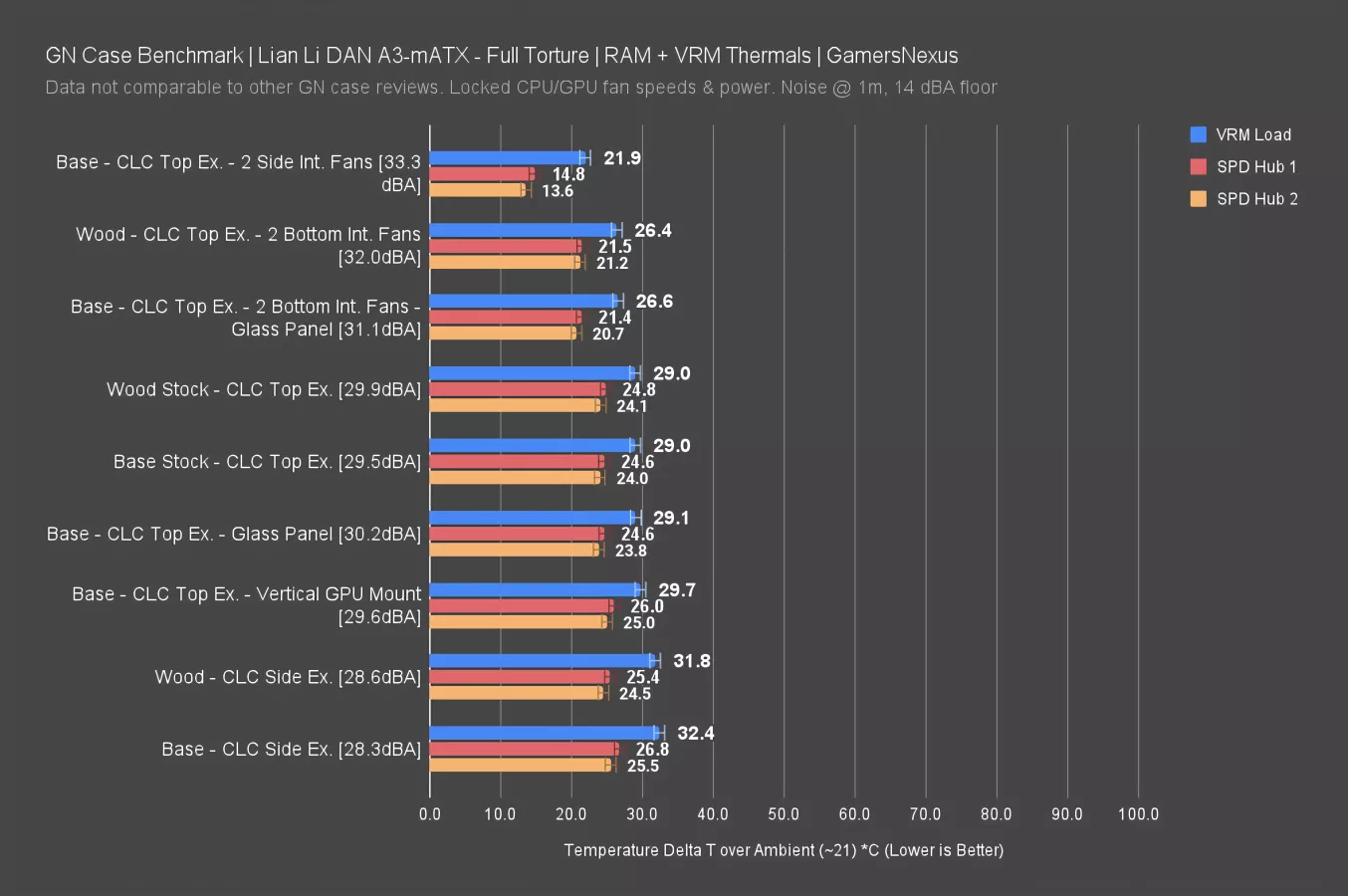
Next we’ll take a brief look at RAM and motherboard VRM temperatures. We’ve started tracking these in case reviews to better understand if any hot pockets -- not that kind -- of air build up around those components.
Surprising nobody, it turns out that intake fans blowing air directly at the motherboard is great for the thermals of these components even in spite of the GPU thermals.
Most of the results are within a narrow band of 2-3 degrees. Mounting the CLC to the side as exhaust raises both SPD hubs and VRM temperatures roughly 5C higher, so we wouldn’t recommend that for users who know they’ll be running particularly memory intensive workloads with hot memory.
A3-mATX Conclusion
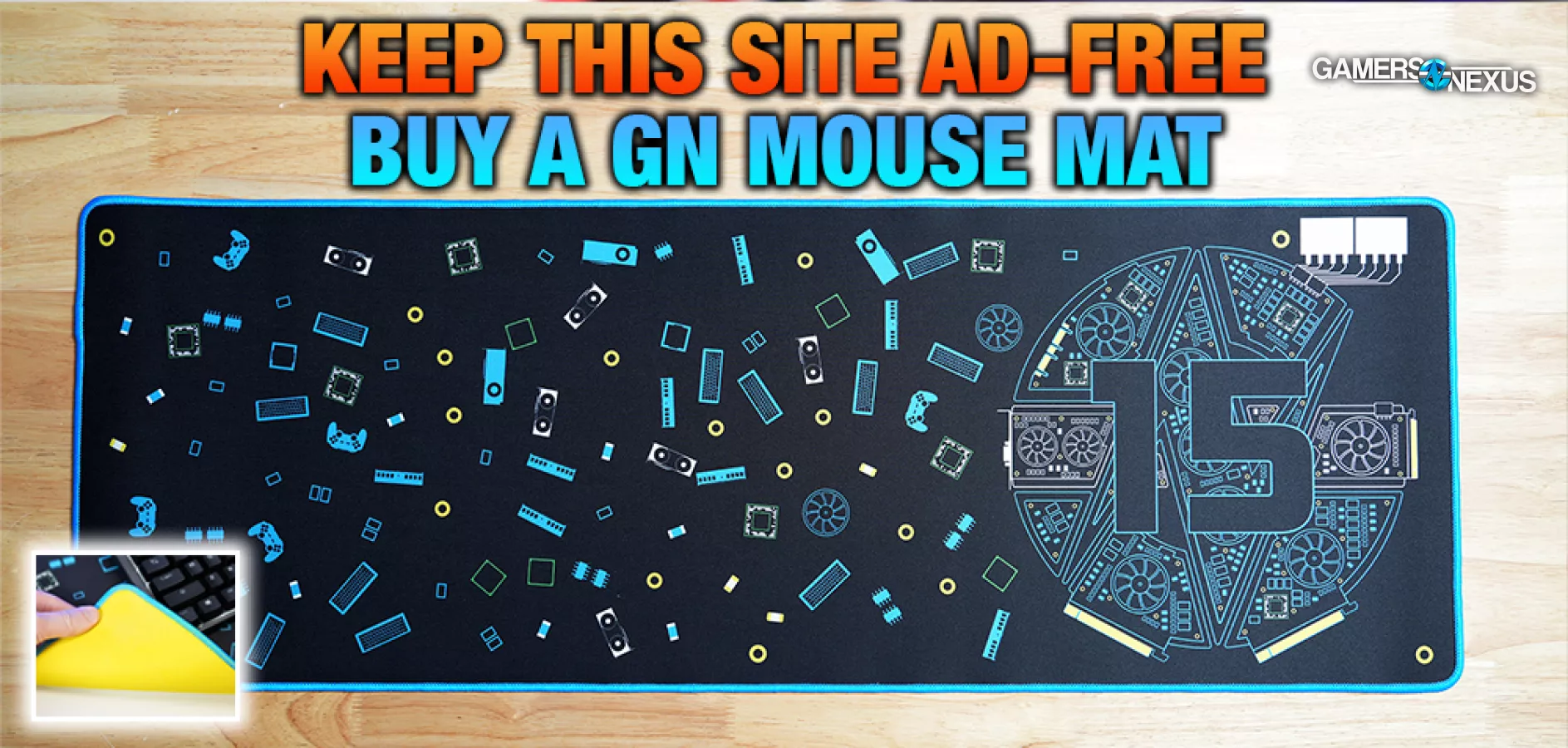
The Lian Li DAN A3-mATX has the right ingredients to be a popular case among budget conscious micro-ATX builders. And if you don’t have a specific reason to want ATX, even if that reason is as basic as just liking how it looks or fills the space, then it may be time to seriously consider going micro-ATX. This case gives a lot of options.
It’s fairly inexpensive at $70-$85 and has good build quality (not counting the plastic front on the base version). We also think adding the option for the wood front panel was the right move by Lian Li, raising the perception of quality. We think the execution was completely fine given the $15 price bump if you buy it new.
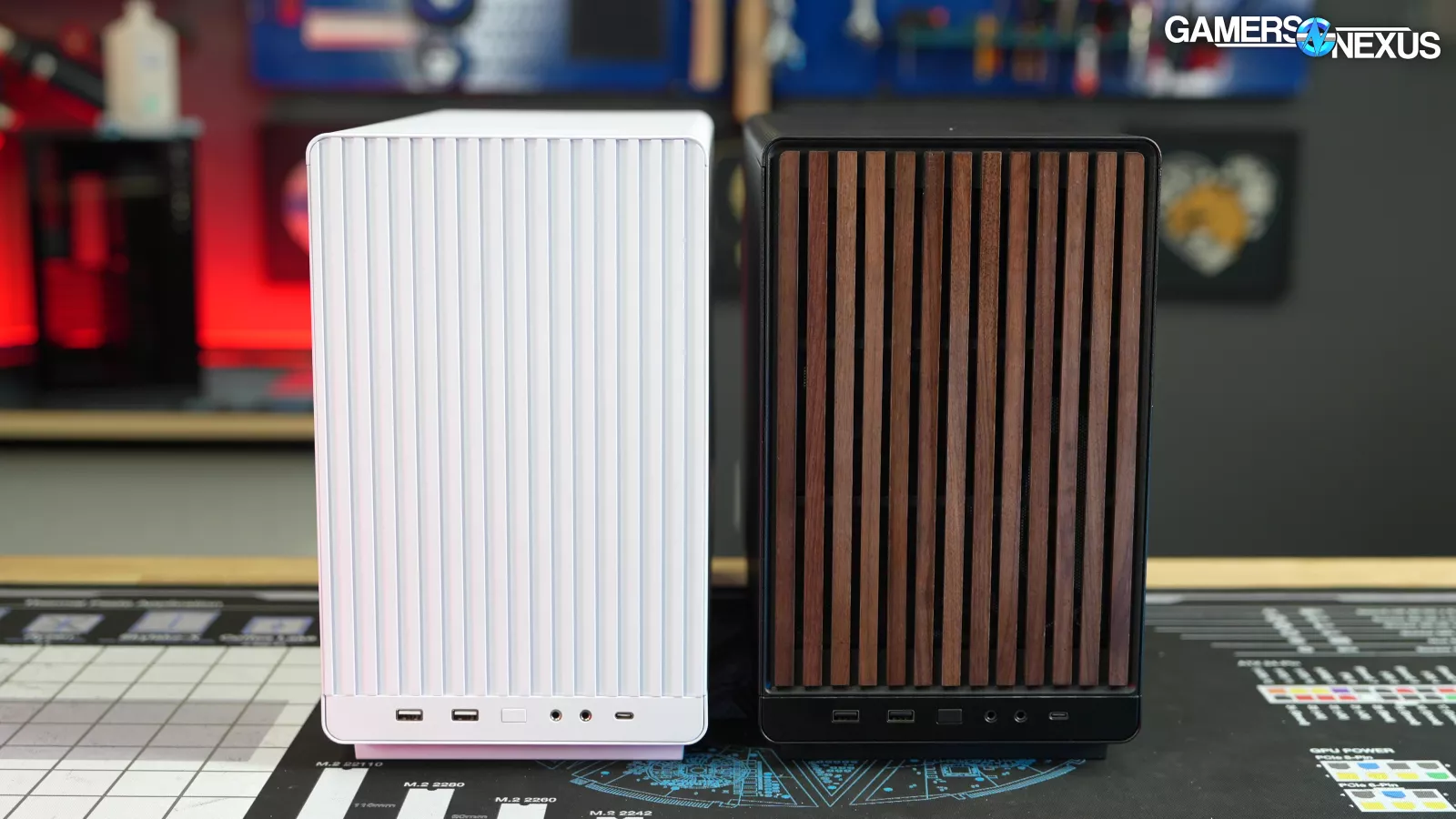
Subjectively, we think it looks way better this way. The mesh front doesn’t make-or-break thermal performance, but was a nice consideration.
Despite its larger size, it doesn’t feel like there’s any considerable wasted space or nonsensical decisions (assuming components large enough to use the volume). We suspect this is a product of Dan Cases’ long history of ITX case design, where every millimeter counts. That mindset still shows despite the A3-mATX being pushed into larger sizes than what anyone would consider SFF.
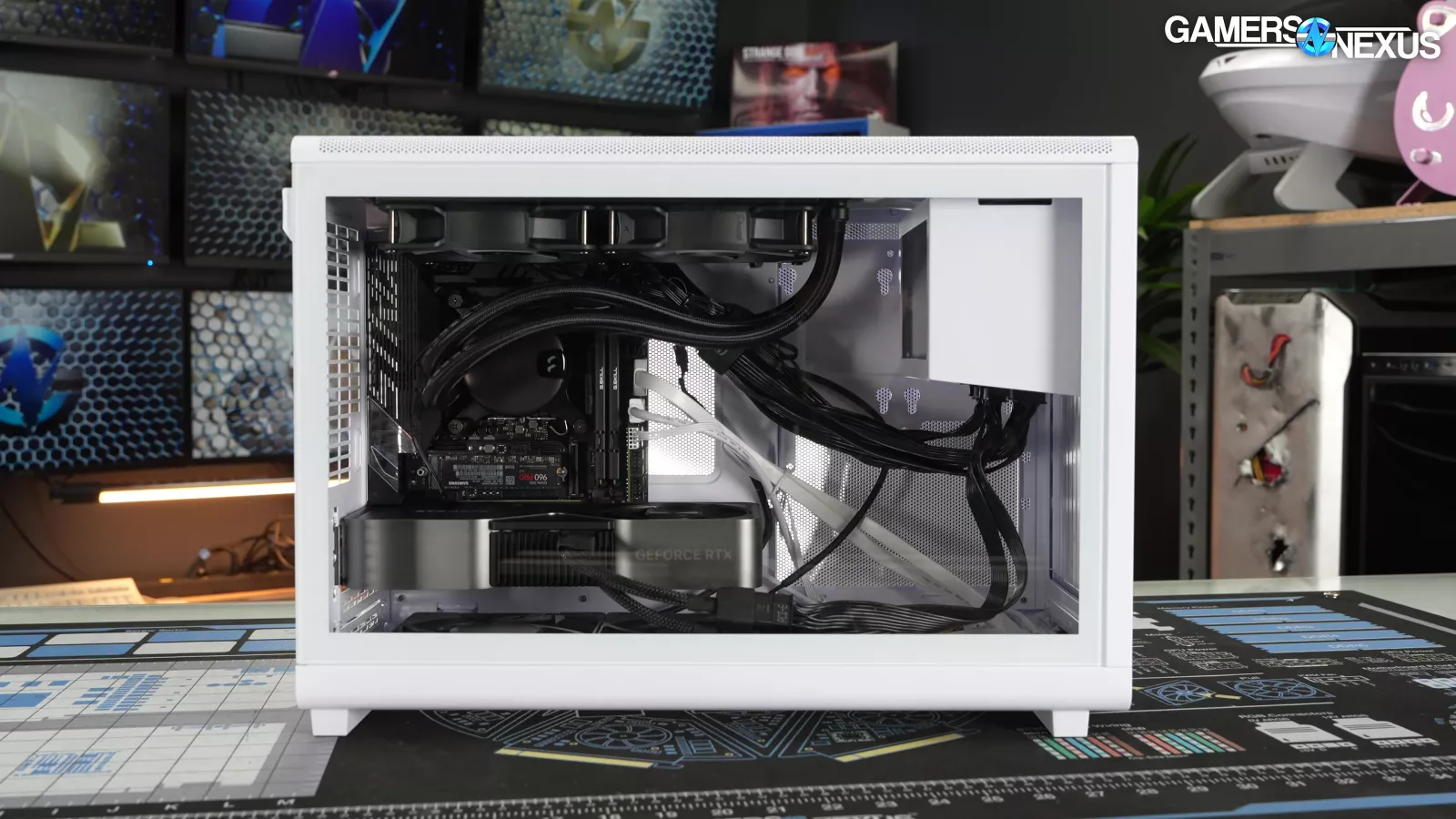
Not much gets in the way while building, either. It’s a very simple build experience. We think this would make a good beginner case, contrary to what we see in more complex ITX cases.
The cable management is relatively spartan. The size brute forces that aspect, but there are limited pre-fab cable management features. Vertical GPU mounting would have limited usefulness, and side mounting intake fans should be done with care. You also give up easy access to the top of the motherboard in some configurations.
This market segment also has some fierce competition from other cases that may offer more absolute value from things like included fans. Micro-ATX isn’t purely about size, unlike going for ultra-small ITX builds, so some competition is also just larger. A quick list of cases to check out would include the Fractal Pop Air Mini RGB, the Montech Air 100 mATX, the Thermaltake View 170, the ASUS AP201, and the SAMA series of cases, like the ARGB Q5. Other than Montech’s Air 100 and Fractal’s Pop Air series, we do not have personal hands-on time with any of these, so can’t vouch for them; however, we wanted you to be aware of other options to help as you research other reviews.
We’re viewing this case like an mATX-sized spiritual successor to the original Cooler Master NR200P. That case basically became a de-facto standard in online discussions as a simple and cost effective choice for anyone that wanted ITX without too many headaches.
We liked the A3-mATX. It’s easy to work with, fits a wide range of CPU coolers and video cards, and it’s relatively “cheap” (by modern standards) for the quality. Thermals are solid as long as you set up a good airflow pattern and avoid making the fans fight each other.
Overall, we’re neutral to positive on the A3-mATX. It’s straightforward, the cons are relatively inconsequential with planning, and there’s not much to complain about. The target user for this case would be those who don’t need full ATX size, but also don’t want to pay the ITX tax. It hits the “good enough” mark in just about every critical area. But for a $70 to $85 case, “good enough” becomes “good.”
